Reef Tank
Lawnmower Blenny
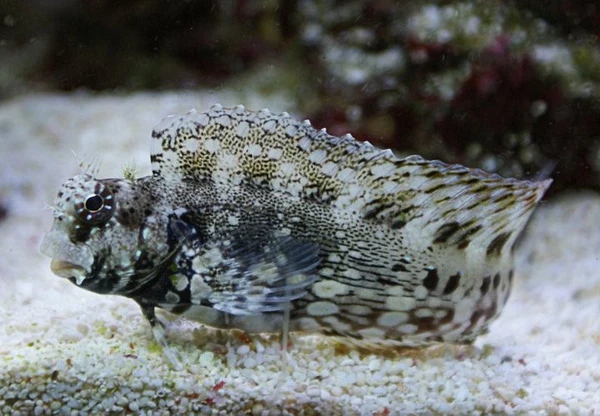
Diet: Herbivore
Size: 5.5 inches
Life Span: 2-4 years
Blennies have elongated bodies with relatively large eyes and mouths and their dorsal fins are continuous and long.
Generally they are benthic fish and may burrow in sandy substrates or inhabit reef crevices. The Lawnmower Blenny is named that for its ability to consume algae growth from the rocks and glass. However, plant material only makes up for about 15% of its diet. He is mostly a detritovore, which means that they feed on dead organic material. Lawnmower blennies are perfect for aquariums for their ability to keep the sand, rocks and glass clean!
Regal Blue Tang
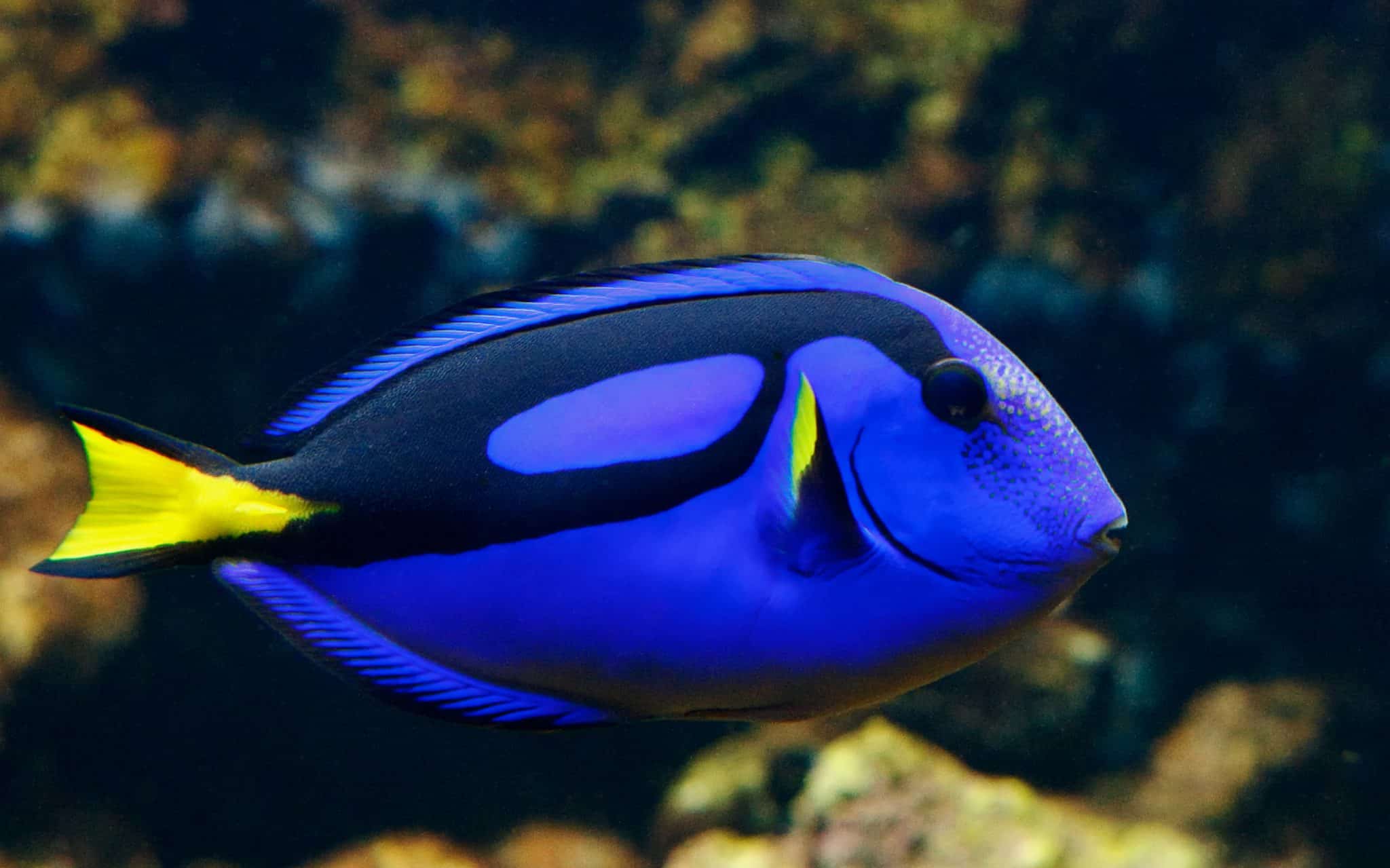
Range: Indo-Pacific, Great Barrier Reef
Diet: Zooplankton in the wild
Size: up to 12 inches
Life Span: 8-20 years
The Regal Blue Tang is known by many names among which is the Blue Tang and Blue Hippo Tang. They are part of the surgeon fish family which the defining characteristic is the scalpel-like spine on the base of their tail. For the Blue Tang, the spine is yellow and located on the yellow part of their tail. It is used as a mode of defense towards threatening fish.
They eat algae which is instrumental in coral reefs because it keeps algae at low levels so that they don’t choke out corals. The Regal Blue Tang has a small mouth and a single row of teeth to help them get into the tight crevices of rocks and corals.
Regal Blue Tangs live in pairs or in small groups or schools of 8 to 14 individuals. Males will aggressively court the femals and they can quickly spawn. They release the eggs and sperm in the evening time where they float near the surface of the water because of a tiny droplet of oil in each egg. The eggs will hatch within 24 hours of being fertilized.
We don’t recommend eating them. It is used as bait fish in commercial fishing because of the strong odor on the flesh from certain toxins. If consumed by people, then it causes ciguatera poisoning. Symptoms include diarrhea, vomiting, numbness, itchiness, temperature sensitivity, dizziness, and weakness.
Yellow Tang
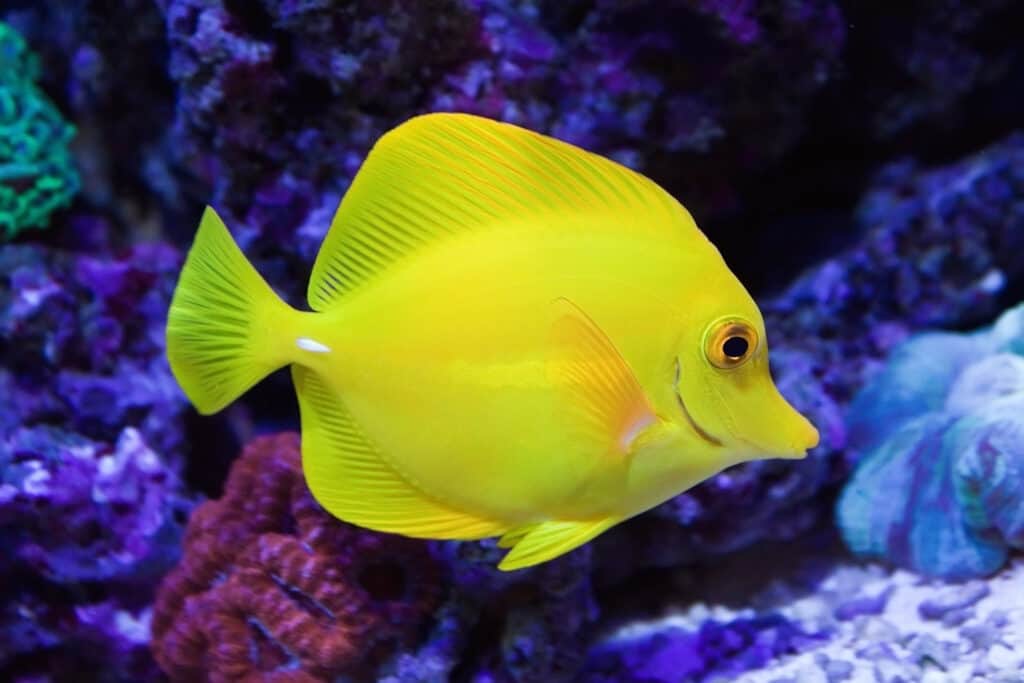
Range: South Pacific Ocean near Hawaii
Diet: Algea and meat based aquarium food
Size: 7-8 inches
Scientific Name: Zebrasoma flavescens
Life Span: 30 years maybe longer
In Latin, the name “flavescens” means yellow. They are bright yellow during the day and at night that yellow dims developing a brownish patch and a horizontal white band. That horizontal white band also is a sign of stress from the fish.
They are part of the surgeonfish family. A defining characteristic is the scalpel-like spine on the base of the tail which are very sharp. It is easiest to see on the Yellow Tang because the spine is white in contrast to the yellow body.
Yellow tangs can be a cleaner to the algal growth that occurs on marine turtle shells. This is possible by the single row of teeth in its small protruding mouth.
They start life as clear larvae before development. While they are young, they are in schools with other Yellow Tangs and can actually be herded in the right conditions. They may even play “follow the leader” in and through the surrounding rocks. However, when they get older, they can become more aggressive towards other Yellow Tangs and will travel only in loose schools. Around the full moon, they will gather in order to spawn.
They are covered in a mucus that protects them from parasites and bacteria as well as making them less resistant to water which allows them to swim faster.
Powder Blue Tang
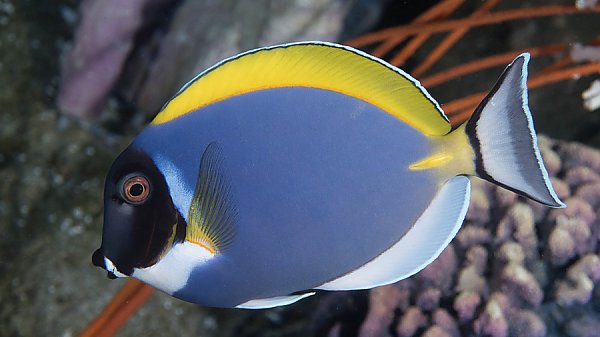
Range: Tropical waters of the Indian Ocean
Diet: Omnivore
Size: up to 9 inches
Life Span: 5 years in the wild. Up to 10 years in captivity
They are part of the surgeon fish family which the defining characteristic is the scalpel-like spine on the base of their tail. Its spine is yellow against the pale blue of its scales. They are able to extend these spines outwards to show intimidation and to defend itself from other predators when necessary. They do not have scales to help protect them nor do they produce much skin mucus like other fish so they are more susceptible to disease.
They are solitary, territorial and aggressive with other fish of the same genus.
Blond Naso Tang
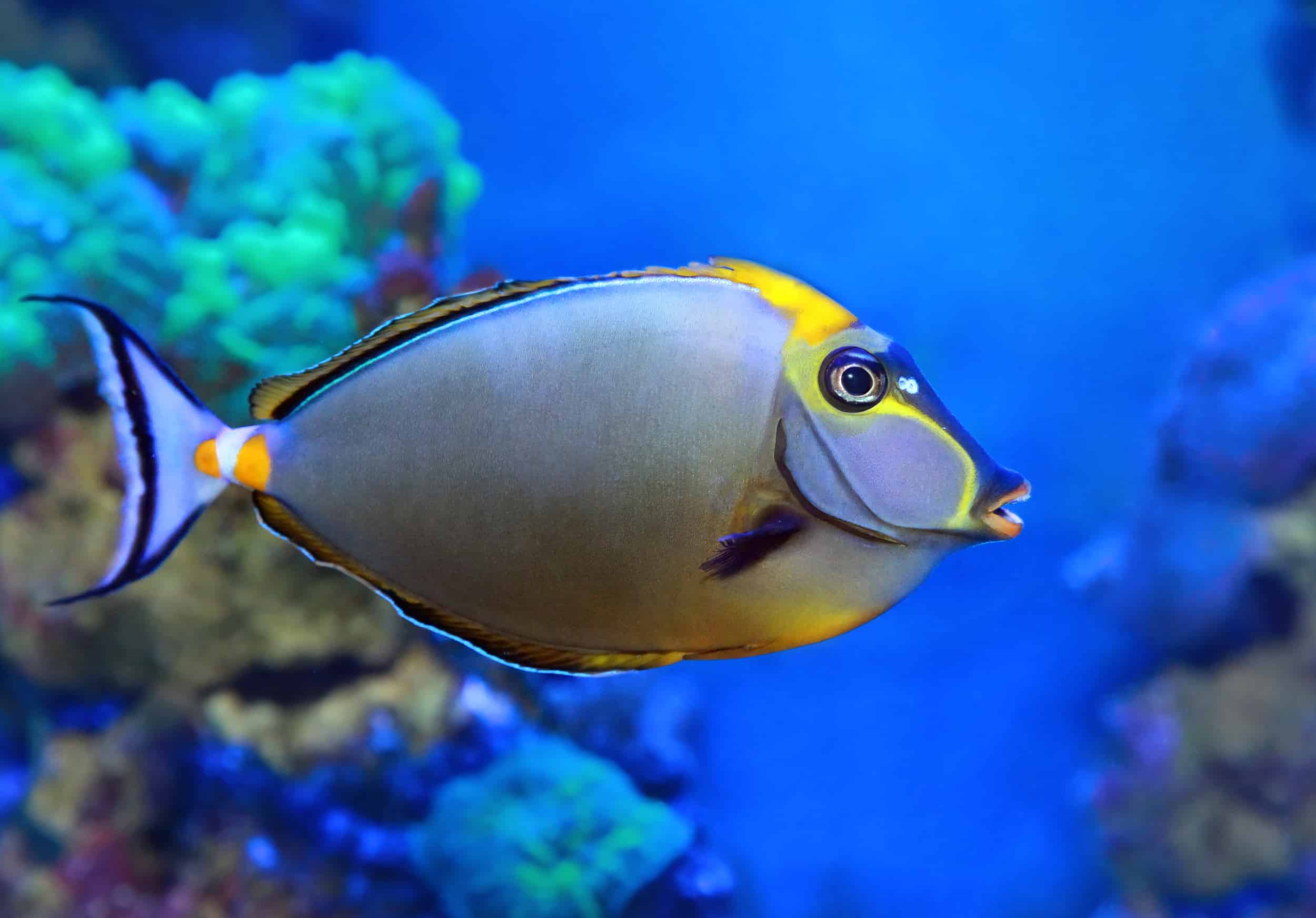
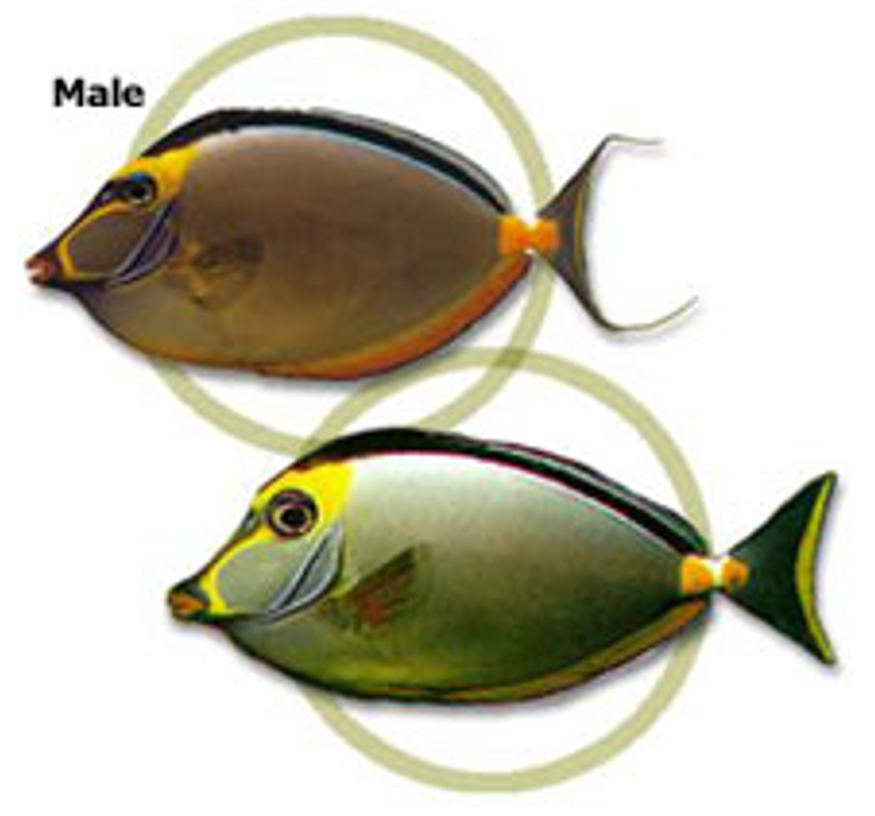
Range: Maldives
Diet: Omnivore
Size: up to 18 inches
Life Span: 10-15 years
Blond Naso Tang is otherwise known as the Orange Spine Unicorn fish. These fish are herbivorous fish that feed on algae that grows on rocks. The reason they seem to have kissy lips is for reaching into tight spots in the rocks to grab food. When they mature the males tend to get a little more fancy in their design. Males tend to become darker and their tail fins grow strands off the top and the bottom having a smaller back fin compared to the female. This is not present in females or young Naso tangs.
These tangs are a crowd favorite when it comes to reef systems. This is due to their love for algae and their beautiful color. They can be dangerous though with a strong bite from what seems like soft kissy lips and a spine that is along the caudal peduncle, which is the back of the tail.
Red Sea Sailfin Tang
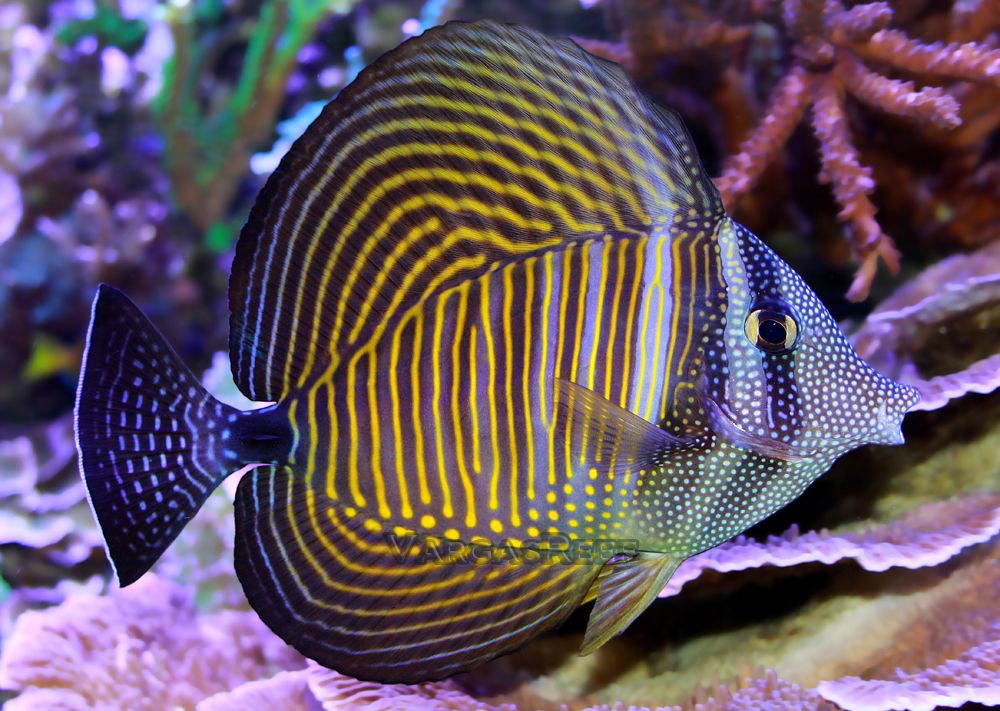
Range: Indian Ocean from northern Red Sea to South Africa
Diet: Omnivore
Size: up to 16 inches
Life Span: 5-7 years in captivity
They are part of the surgeon fish family which the defining characteristic is the scalpel-like spine on the base of their tail. They have a dark spine that is surrounded by a blue zone.
Normally they feed on algae, macroalgae and plankton. However, a few individuals have been seen feeding on jellyfish and comb jellies in the Red Sea.
White Freckled Tang
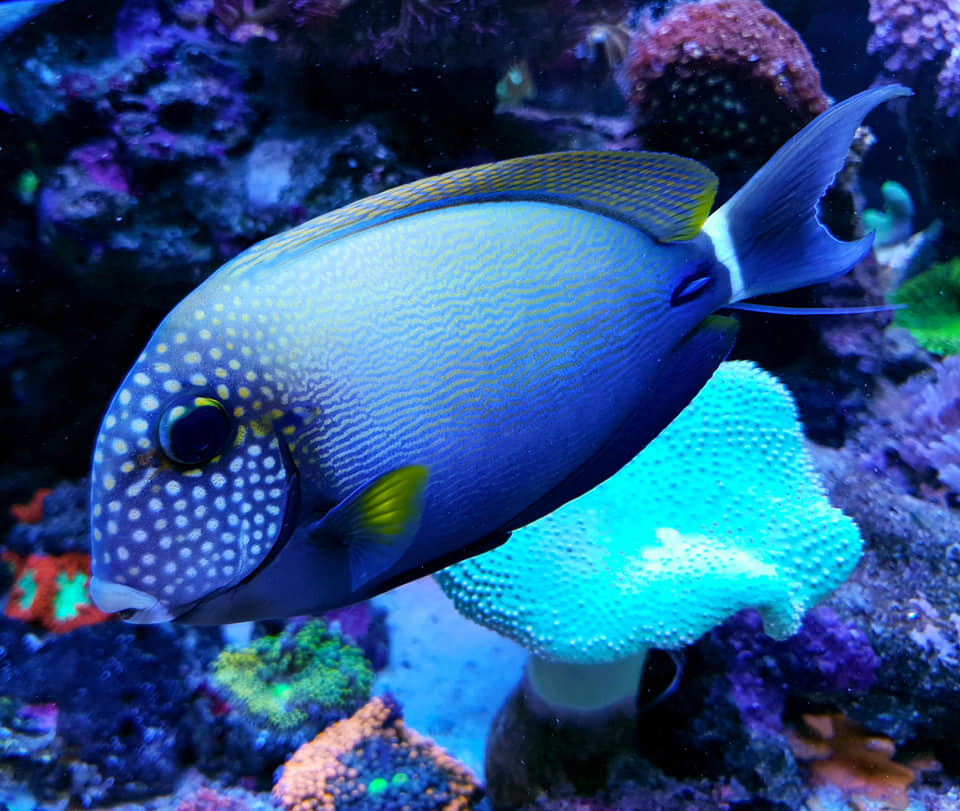
Range: Indo-Pacific Ocean
Diet: Omnivore
Size: up to 16 inches
Life Span: up to 25 years
They are part of the surgeon fish family which the defining characteristic is the scalpel-like spine on the base of their tail. They have a dark spine that is surrounded by a blue zone.
Normally they feed on algae, macroalgae and plankton. However, a few individuals have been seen feeding on jellyfish and comb jellies in the Red Sea.
Anthias
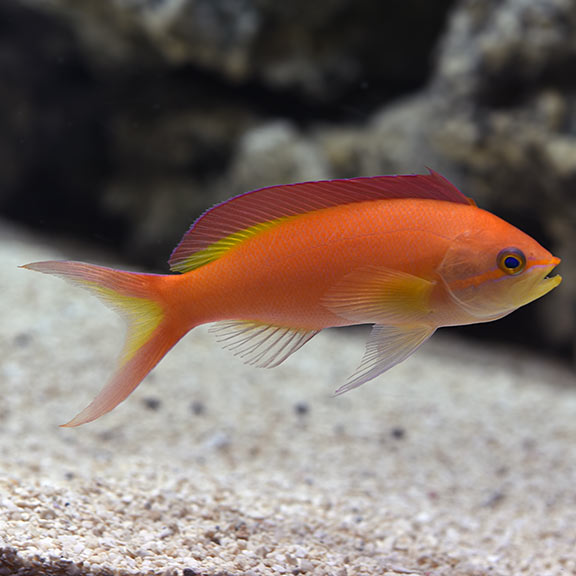
Range: Indo-West Pacific Region
Diet: Carnivore including zooplankton, mysis shrimp and brine shrimp
Size: up to 5 inches
Life Span: 2-5 years
Anthias are protogynous hermaphrodites which means that the fish are born female and the dominant one will change to the male. The dominate fish will also tend to be the bigger sized fish. In this tank, the larger males look more pink than the orange females. In one harem, a school of anthias fish, there is one dominant male, sometimes another one or two males, and 2-12 females. Harems combine together allowing these fish to travel by the thousands.
They are a peaceful and very colorful fish that swim among the coral reefs.
Snowflake Clownfish
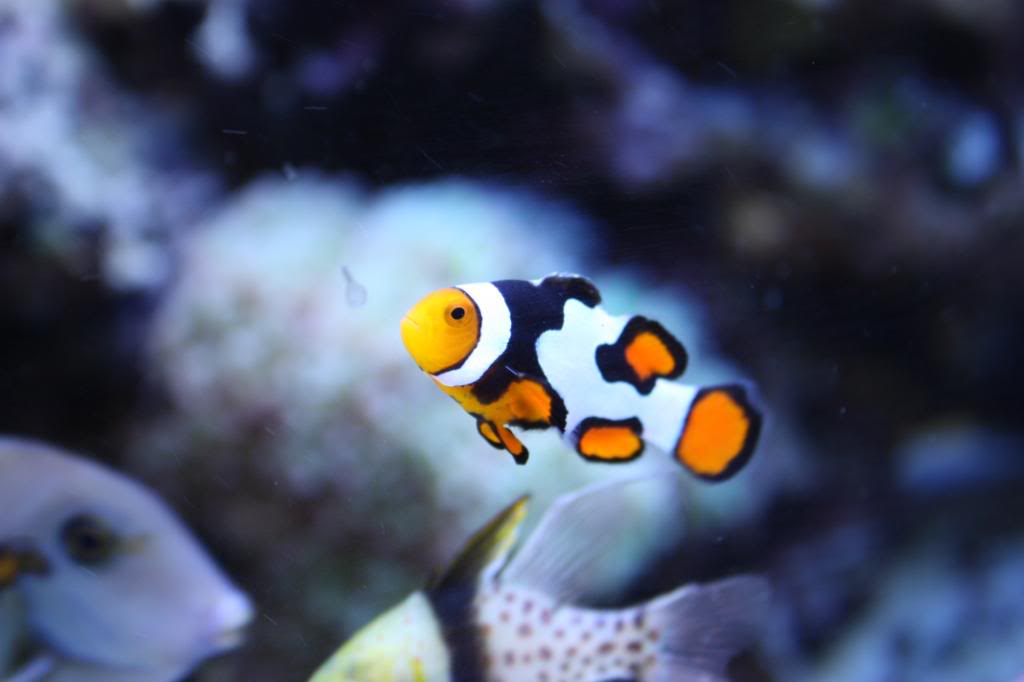
Range: Eastern Indian Ocean and Western Pacific Ocean, North Australia, Southeast Asia and Japan
Diet: They are omnivores. They can eat the undigested food from their host anemones, zooplankton and algae
Size: up to 4 inches
Life Span: 3-5 years
Clownfish host anemones and they create a symbiotic mutualistic relationship. The anemones protects the clownfish from predators and provide food through their scraps and in return the clownfish defend the anemones from predators and parasites.
The mucus coating of the clownfish is based on sugars rather than proteins which makes the anemone fail to recognize them as a food source and does not sting them
Clownfish are hermaphrodites which means that they are born male and the most dominant male will turn female. Their group is called a harem within which is a hierarchy so the largest and most aggressive female is found on the top tier of their harem.
They are called snowflake clownfish because of the middle white stripe. Each individual has a different pattern just like snowflakes do.
Coral Beauty Angelfish
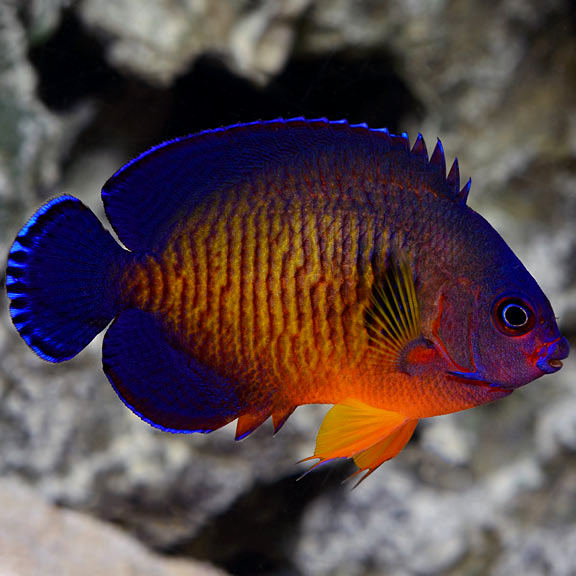
Range: Indo-Pacific Ocean
Diet: Omnivore
Size: up to 4 inches
Life Span: 10-15 years
They are also known as the Twospined Angelfish and the Dusky Angelfish. Coral Beauty Angelfish are a type of dwarf angelfish so they only grow to about 4 inches where as a full size angelfish is between 8-12 inches. Dwarf angelfish are also considered reef safe as they don’t normally nip at corals whereas the full size angelfish are not considered reef safe as they have a tendency to nip and eat corals.
Six Line Wrasse
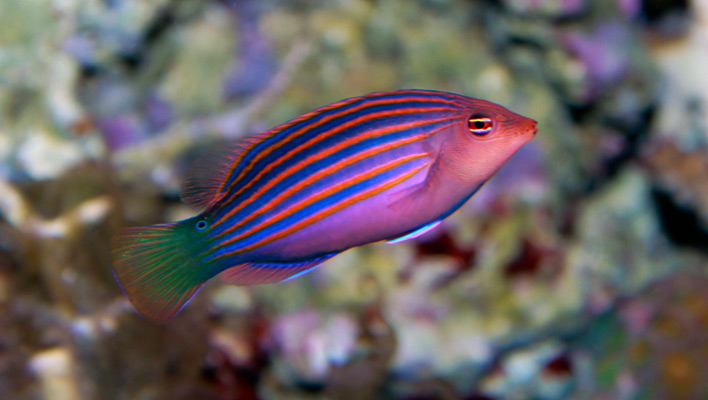
Range: Indo-Pacific Region
Diet: Carnivore including small crustaceans and parasites
Size: up to 4 inches
Life Span: up to 20 years
Six Line Wrasse are a secretive species preferring to hide in crevices and rock. At night, they will create a mucus cocoon to mask their scent from predatory fish. They have been known to act as a cleaner fish, removing parasites and copepods from other fish.
Green Mandarin Goby
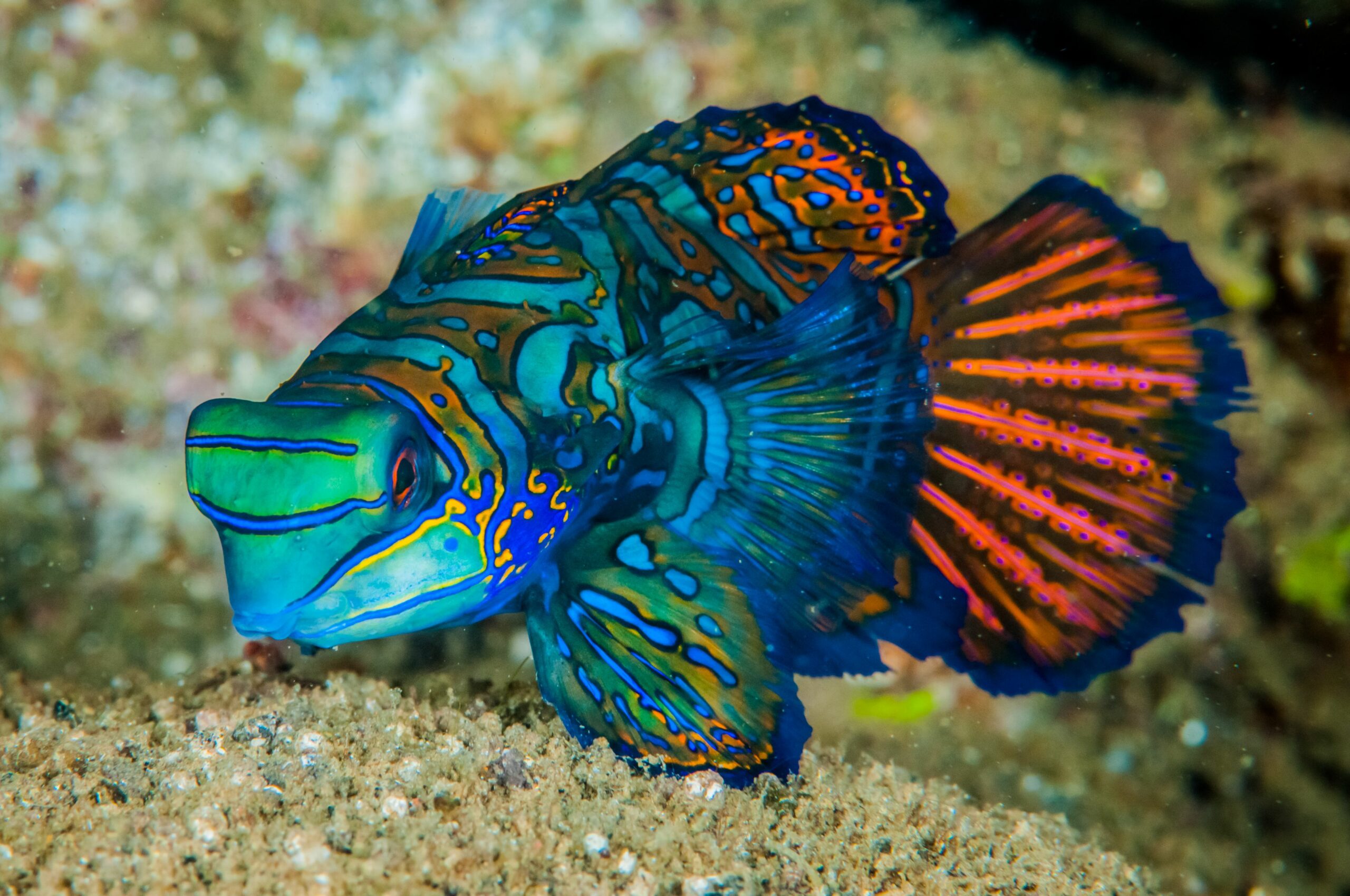
Range: Pacific Ocean
Diet: Omnivores including algae, small crustaceans and invertebrates and fish eggs
Size: 2-4 inches
Life Span: 10-15 years
Mandarinfish have a layer of smelly and bitter slime instead of scales which helps to block disease. This and its bright coloration discourages predators from attacking.
They have large pectoral fins that allows them to “walk” on the sea floor while their pectoral fins are near their center and are nearly transparent. Their name comes from their bright coloration evokes the image of the robes of an Imperial Chinese mandarin.
Spotted Mandarin Goby
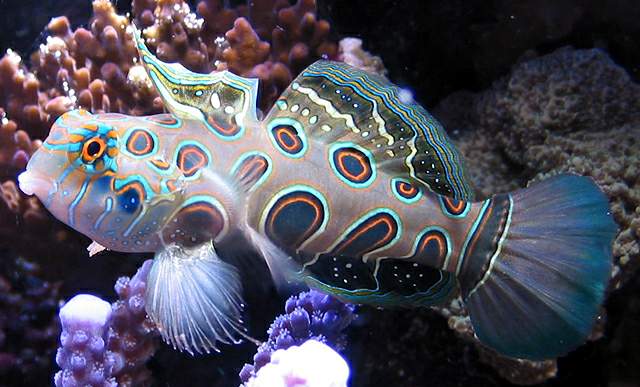
Range: Pacific Ocean
Diet: Omnivores including algae, small crustaceans and invertebrates and fish eggs
Size: 2-4 inches
Life Span: 10-15 years
Mandarinfish have a layer of smelly and bitter slime instead of scales which helps to block disease. This and its bright coloration discourages predators from attacking.
They have large pectoral fins that allows them to “walk” on the sea floor while their pectoral fins are near their center and are nearly transparent. Their name comes from their bright coloration evokes the image of the robes of an Imperial Chinese mandarin.
Yellowtail Damselfish
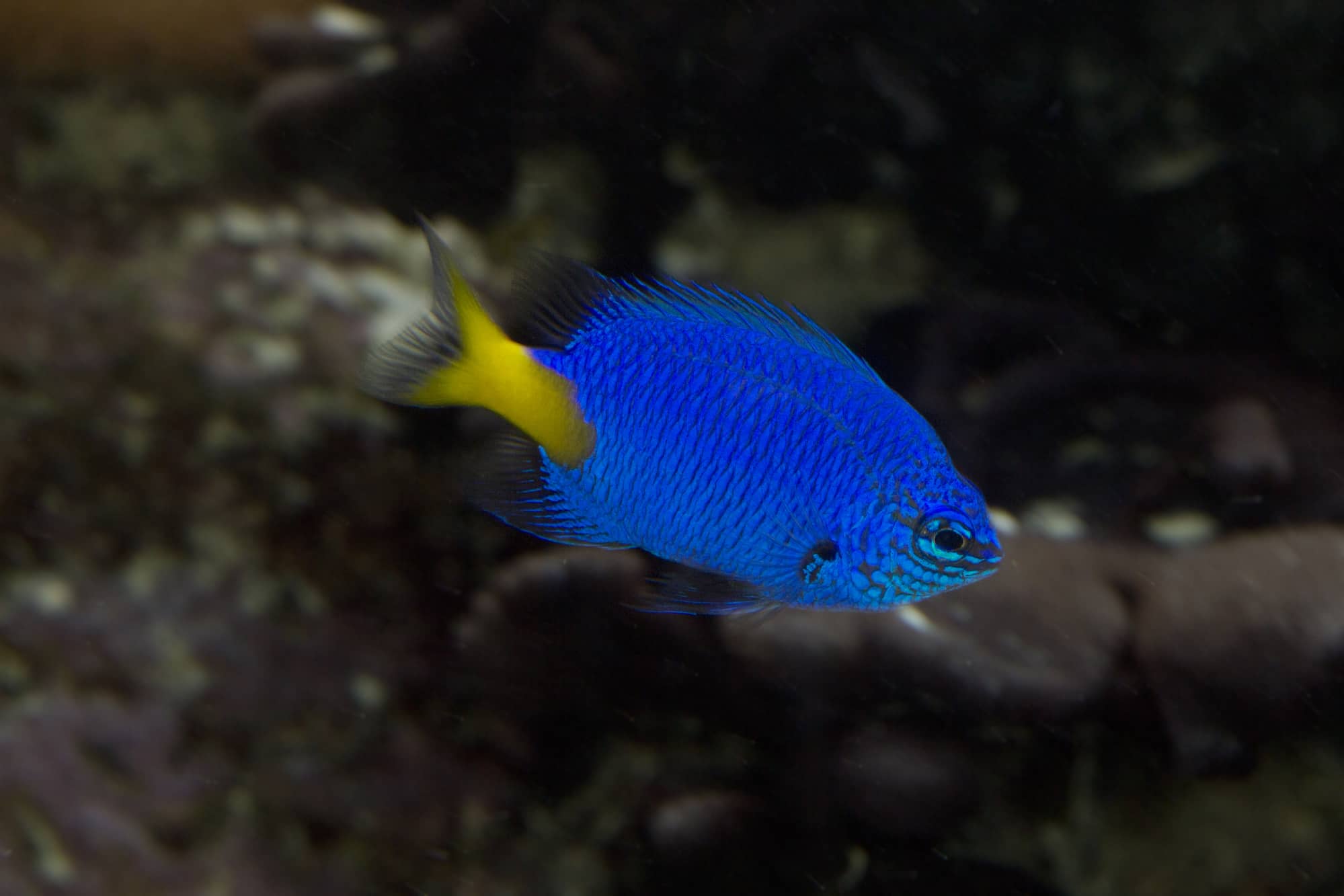
Range: found globally in tropical, subtropical and temperate waters
Diet: Omnivore including algae, small crustaceans and plankton
Size: 2 inches
Life Span: about 5 years
Damsels are very territorial and aggressive towards other damsels that enter into that territory. They spend most of their time foraging for food in the water column.
During the courting process, the males will do a signal jump which is when they rise in the water column and then rapidly swims downward. This causes a pulsed sound. Females will choose the males depending on the vigor they show while swimming and on the number and rates of the pulses they create.
Purple Tang

Range: West Indian Ocean, Red Sea, Persian Gulf
Diet: Filamentous algae in the reefs
Size: 8 to 10 inches
Life Span: 10 years or longer
Purple Tangs can grow to a max size of about 25 cm (9.8 in.). They have a purple body with a yellow tail and black spots covering their faces. Some have black horizontal lines that run along their bodies. The center of their bodies can sometimes be a darker shade of purple relative to the rest of their body. Most have yellow tips on their pectoral fins. Like all fish of the genus Zebrasoma, they have a large dorsal fin and anal fins and an extended snout used to forage for algae within rocks. When their dorsal and anal fins are fully extended, these fish often look like disks.
Purple tangs inhabit coral reef ecosystems. They can be found between 2-20 meters (6-65.5 ft.) deep. Adults typically swim in shoals while juveniles are solitary.
Purple Tang secrete a type of mucus, or slime, from their skin. This slime provides protection against parasites and infections and helps the Purple Tang to move through the water faster. Some fish species also release toxins in their slime which ward off enemy attacks and can make fish or even humans sick.
Gem Tang
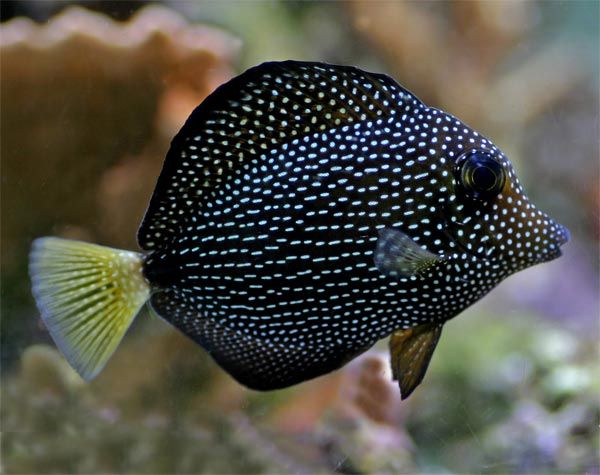
Range: Western Indian Ocean
Diet: Omnivore
Size: up to 9 inches
Life Span: 10 years
The Gem Tang lives in deeper waters and surge zones which makes collecting this fish more challenging and makes him more rare in the aquarium trade. It is famous for its brilliant white spots across its iridescently shimmering black body with splashes of yellow on its anal fin.
The Gem Tang is part of the surgeon fish family and has the scapel-like spine at the base of its tail that it is able to extend outwards to defend itself against predators.
Achilles Tang
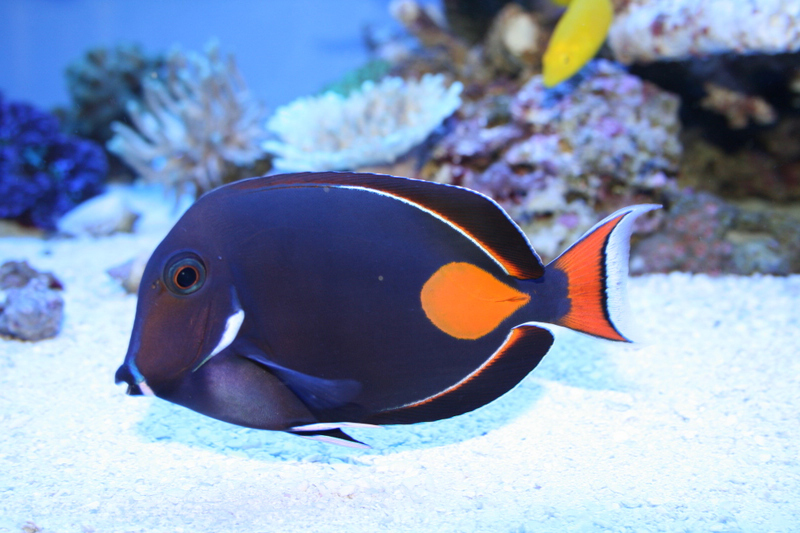
Range: Pacific Ocean
Diet: Omnivore
Size: up to 8 ½ inches
Life Span: 7 years
The Achilles Tang is also known as the Red-Tailed Surgeon and is normally a very dark brown to a purple color with highlights of white and orange. They also have the orange scapel-like spine as is common in the surgeonfish family that camoflauges in with the orange background. They are able to extend this spine outwards to help defend itself against predators.
Convict Tang
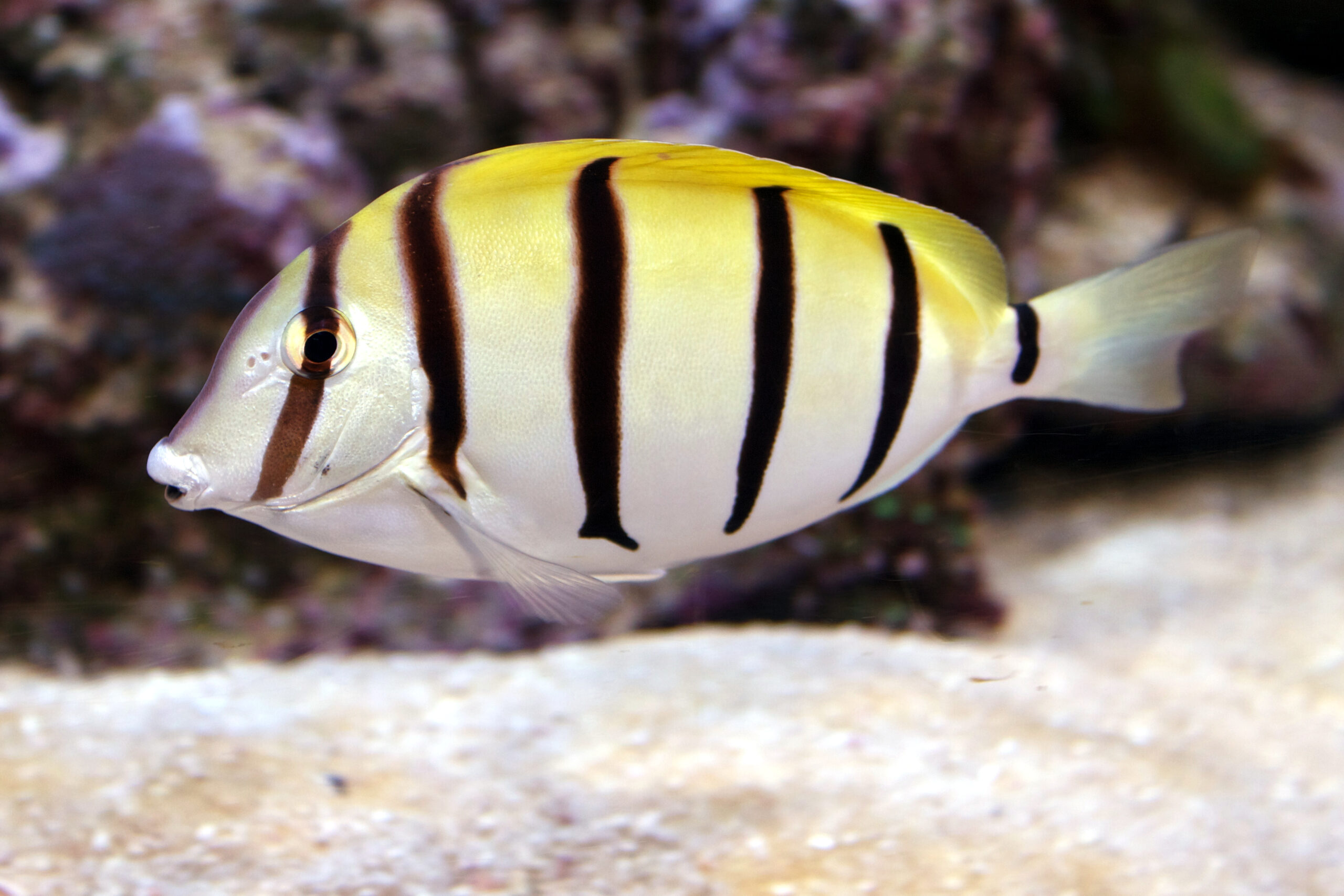
Range: Indo-Pacific Region and eastern Pacific
Diet: Omnivore including algae and mysis shrimp
Size: 7 inches
Life Span: 5-7 years
Convict Tangs are part of the surgeon fish family with the distinctive characteristic of the scalpel-like modified scale at the base of the tail that they are able to extend from the body. This scale is sharp and helps protect them from danger.
These tangs will swim in schools and are the more peaceful species of tangs.
File Fish
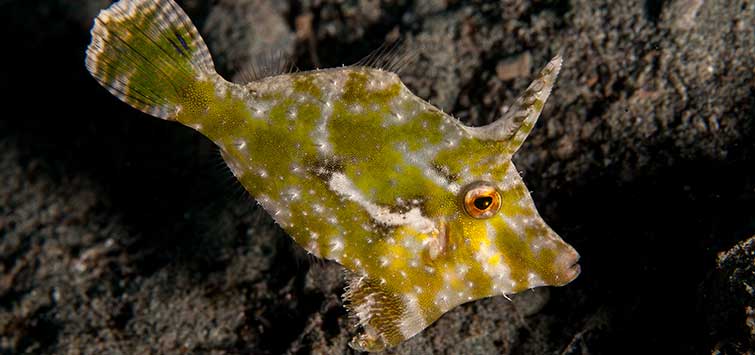
Range: Atlantic, Pacific, and Indian Oceans
Diet: Omnivores including algae and benthic invertebrates
Size: most species are less than 24 inches
Life Span: 4-6 years
Filefish are part of the same family as triggerfish, pufferfish and trunkfish
They are called filefish because of their rough non-overlapping scales with small spikes.
They have two spines on their head. They are able to extend one spine and the second spine is used to lock that first spine into place. They are able to erect the dorsal spine and pelvis simultaneously to make it more difficult for a predator to remove the fish from a cave.
Japanese Swallowtail Angelfish
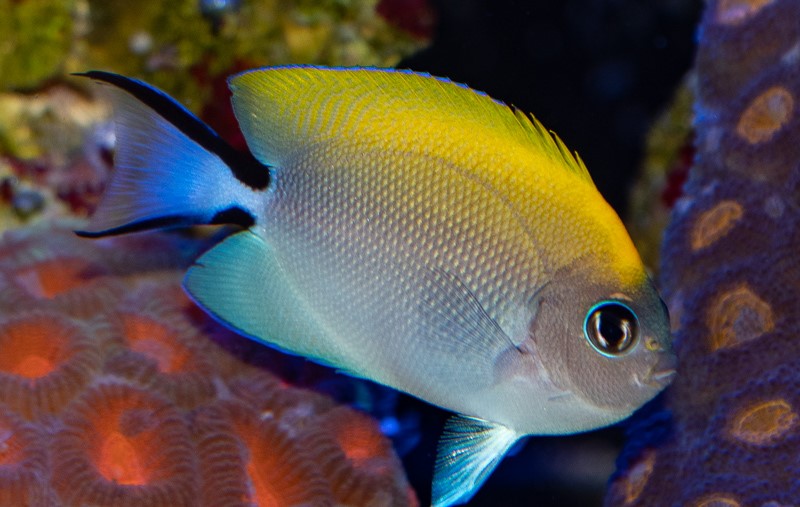
Range: Southern Japan to the northern Philippines
Diet: Omnivore
Size: 8.3 inches
Life Span: 10-15 years
The Swallowtail gets its name from its forked tail that narrows at the base creating the swallow tail. You can tell that the fish is a male by its silver white body with black vertical stripes whereas the female has a snow white body with a bright yellow splash on its back and a blackstripe on the top and bottom of the tail.
These are a unique angelfish that is reef safe and not nip at the corals or invertebrates unlike the other angelfish.
Lineatus Fairy Wrasse
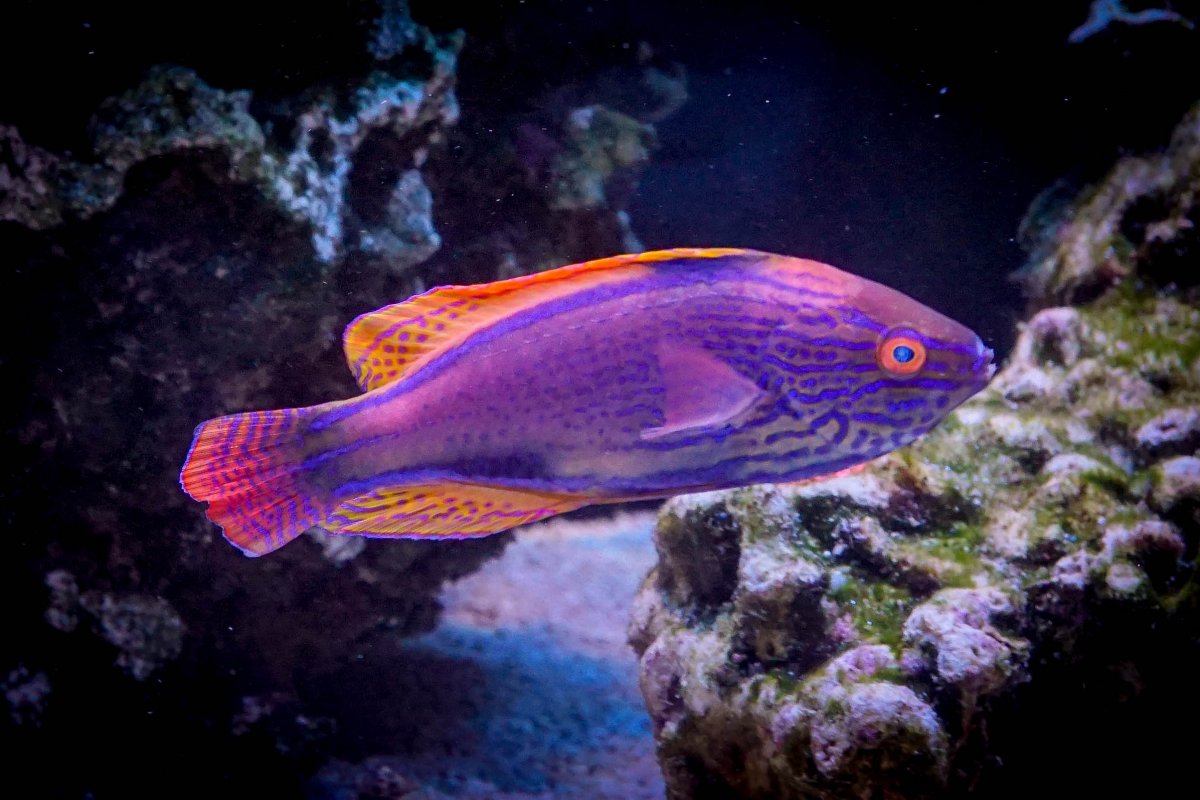
Range: New Caledonia and Australia
Diet: Carnivore
Size: 5 inches
Life Span: 5 years
The Lineatus Fairy Wrasse has the ability to change their genders from a female to a male if the environment allows for it. The dominant male will have more brilliant colors when compared to the other fish in the school. These wrasses are very peaceful and active and do not harm corals or the invertebrates.
Flame Angelfish
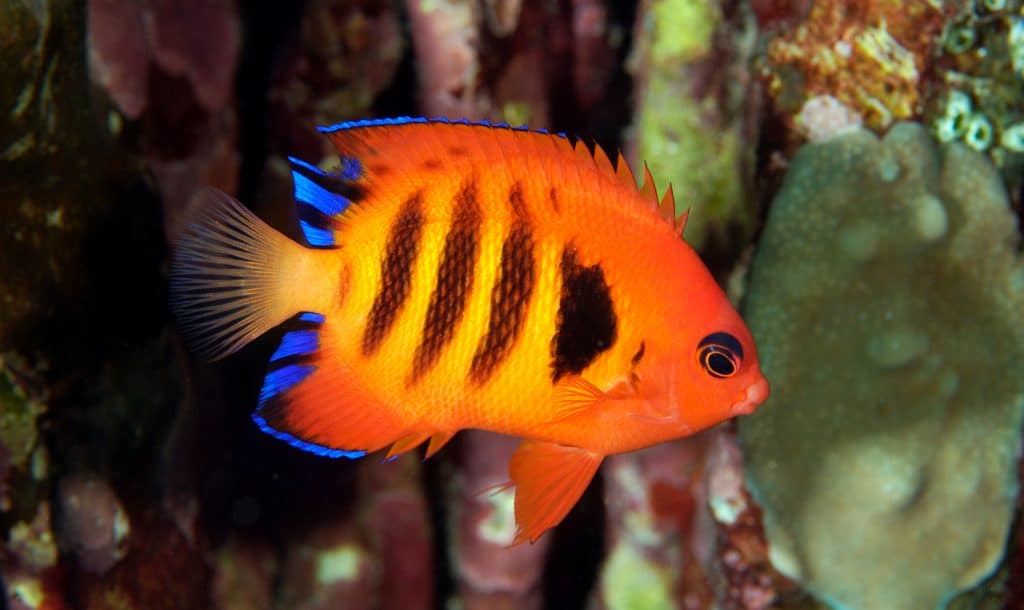
Range: Tropical waters of the Pacific Ocean
Diet: Omnivore including algae and crustaceans
Size: around 6 inches
Life Span: 5-7 years
The Flame Angelfish are also known as the Japanese Pygmy Angelfish. Flame Angelfish are a type of dwarf angelfish so they only grow to about 6 inches where as a full size angelfish is between 8-12 inches. Dwarf angelfish are also considered reef safe as they don’t normally nip at corals whereas the full size angelfish are not considered reef safe as they have a tendency to nip and eat corals.
Mustard Tang
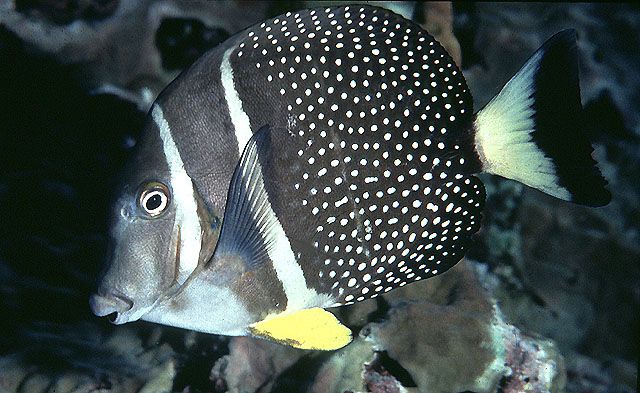
Range: Indo-Pacific Ocean
Diet: Herbivore
Size: up to 10 inches
Life Span: about 25 years old
The Mustard Tang is also known as the Whitespotted Surgeonfish. The white spots may provide camouflage in the chrned up, bubble-filled water. It enjoys habitats that have exposed reefs and rocky shores where it swims in schools.
Unicorn Tang
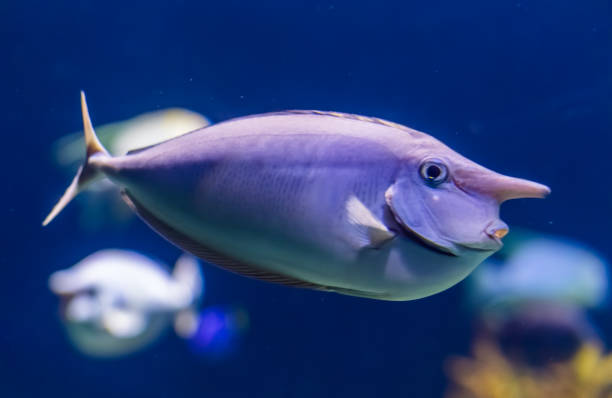
Range: Indo-Pacific Ocean
Diet: Omnivore
Size: up to 28 inches
Weight: up to 12 pounds
Life Span: 30-45 years
In Hawaii, this fish is called kala which means thorn. It has two blue spines on each side of the base of the tail that is scapel like. This allows them to defend themselves against predators. Unicorn Tangs also have a shrot rostrum or a bony horn on their forehead that develops only after the tang has grown to about 6 inches. Their skin is leatherlike instead of scales.
Scooter Blenny
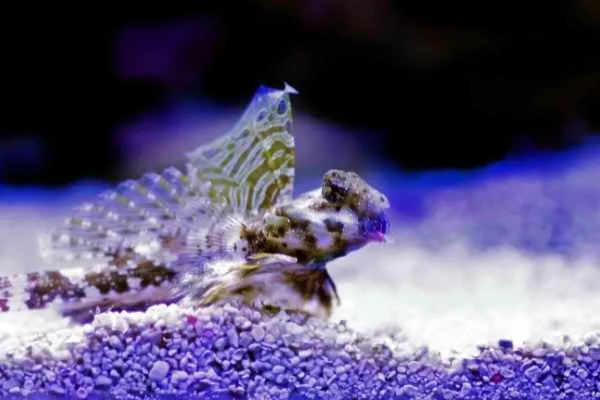
Range: The southwest Pacific Ocean from Japan to the Marquesan Islands.
Diet: Omnivore including copepods
Size: 3 inches
Life Span: about 7 inches
The Scooter Blenny is also known as the Scooter Dragonet. Even though it is called a blenny, it is not a part of the blenny family. They have a camouflage body to help them hide from predators. Scooter blennies have a diamond shaped body with fins that act similar to legs that they can scoot, waddle, and hop around.
Turbo Snail
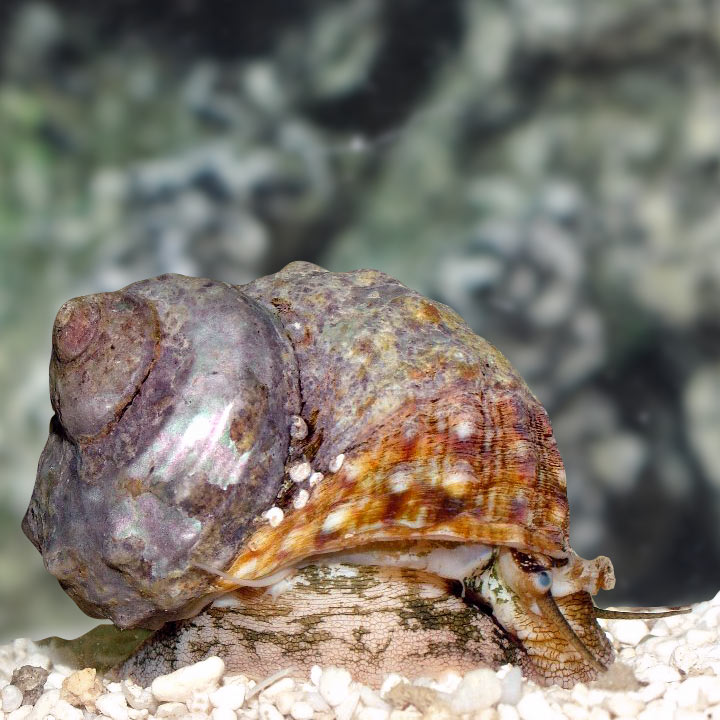
Range: The Gulf of California off the coast of Mexico
Diet: Herbivore
Size: 4 inches
Life Span: up to 25 years
The first turbo species were found 100 million years ago. They are a genus of large sea snails and includes gills that allows them to breathe underwater as well as an operculum that acts like a trap door that will help cover their main body and foot when it is in danger. These snails grow their own shells so if they are somehow separated from them, they will die.
Astrea Snail
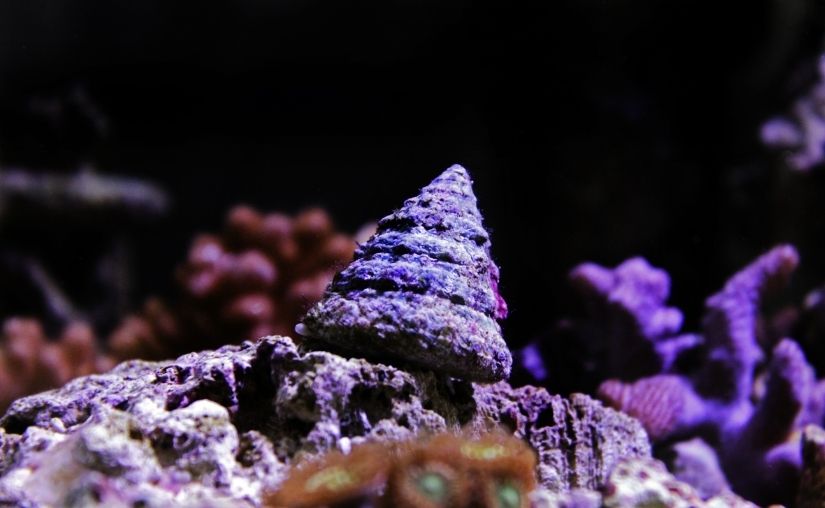
Range: Caribbean Sea and the Gulf of Mexico
Diet: Herbivore
Size: up to 2.4 inches
Life Span: up to 5 years
This genus is a medium to large sea snail. Astraea means star which references to their star-shaped snail or also known as star shells. The have gills that allows them to breathe underwater as well as an operculum that acts like a trap door that will help cover their main body and foot when it is in danger. These snails grow their own shells so if they are somehow separated from them, they will die
Basket Seastar
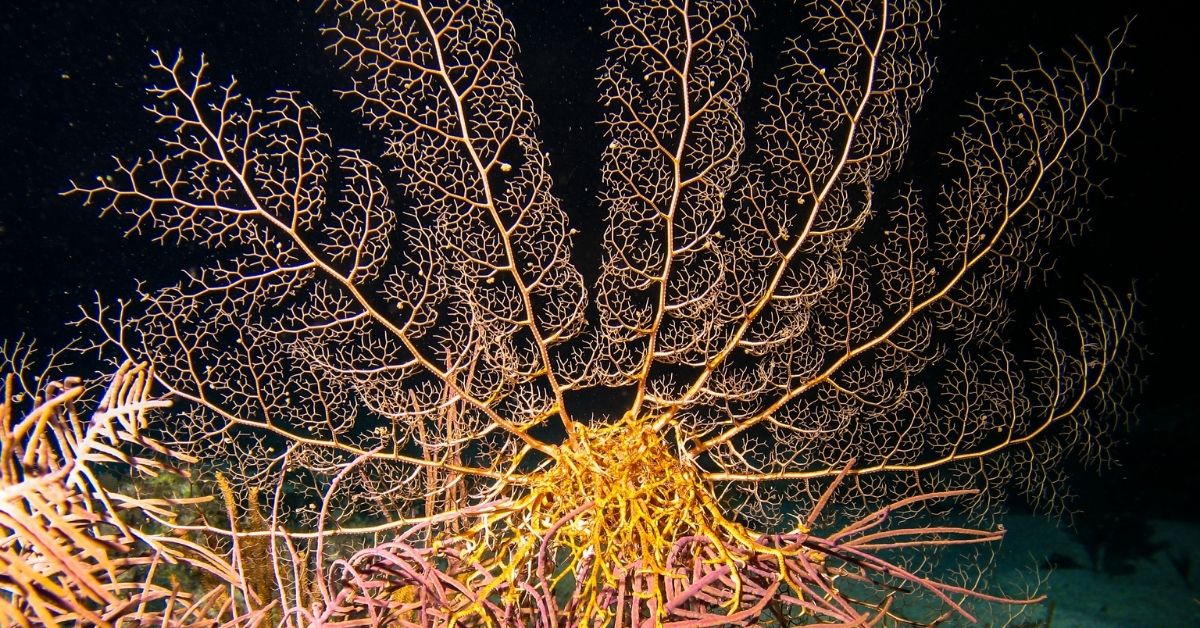
Range: Found in all major marine provinces from poles to tropics
Diet: Detritivores including dead plants and animals and small crustaceans and worms
Size: arm length 28 inches, disk diameter 6 inches
Weight: up 11 pounds
Life Span: up to 35 years
Basket Starfish are closely related to Brittle Stars. They have five long, slender, flexible arms that they can use to move themselves around and all of their internal organs never enter the arms like they do in other starfish. The underside contains the mouth which has five teeth and it serves as the butt as well.
They have tube feet and instead of blood, they use sea water to circulate oxygen through their body.
Clam
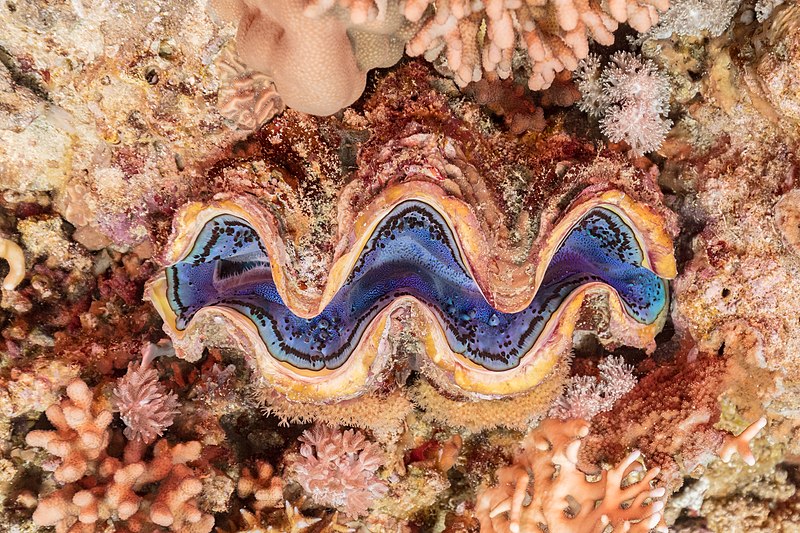
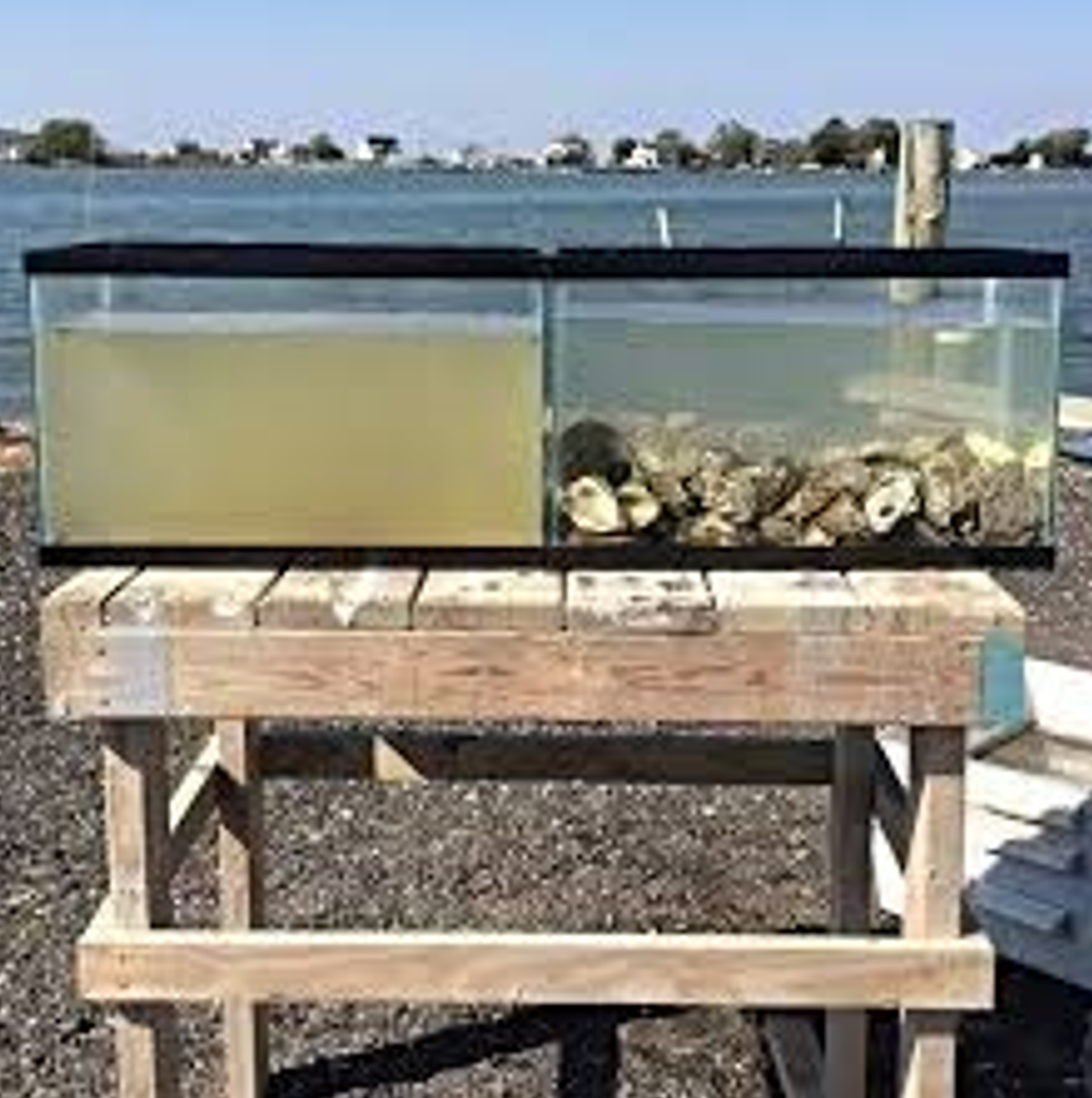
Diet: Small organisms and algae
Size: 3-16 inches
Scientific Name: Scrobicularia plana
Life Span: Up to 500 years
This is a genus of a bivalve mollusk which is a mollusk with two hinged parts of a shell that encloses the body. The shell is made of calcium carbonate. The two halves of the shell are called valves and are joined by a flexible ligament with interlocking “teeth” to form the hinge. This allows the clam to open and close at their will.
Clams will bury themselves in the sand to make sure that they are upright to filter feed. Their gills have evolved into ctenidia which is a specialized organ to feed and to breath. It is the feather like structure on the right-hand side of the animal in this photo.
Clams are also used as a bioindicator to measure the pollution in the water or in other words, a natural way to see how polluted the water really is. Bivalve mollusks are able to accumulate heavy metals and organic pollutants in their tissues because they are not able to metabolize them. There are some limitations to this measurement because the clam will only absorb depending on its species, age, size, and time of year. Crushed shells are able to continue to swap its calcium for the heavy metals so the clam doesn’t even have to be alive for them to help clean the environment.
The left tank has no clams, the right tank has clams. All other conditions are the same.
Ritteri Anemone
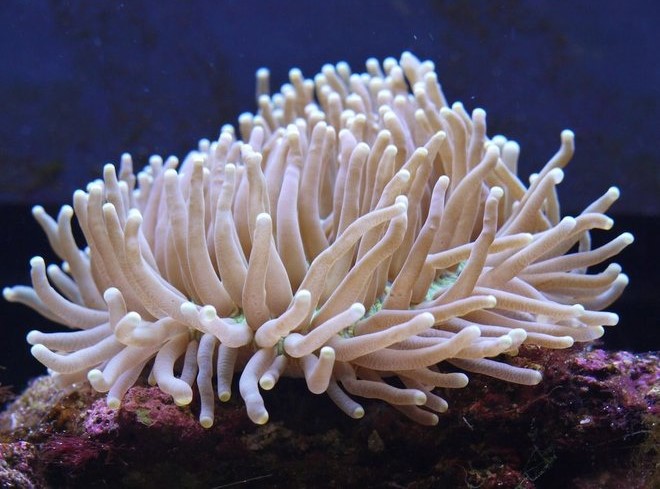
Range: Indo-Pacific Region
Diet: Photosynthesis and carnivore including small invertebrates and juvenile fish
Size: 8-20 inches
Life Span: 80 to several hundred years old
Ritteri Anemone have a symbiotic relationship with the algae zooxanthellae which photosynthesizes to give nutrients, energy, and color to the anemone.
Also, has a symbiotic relationship with anemonefish. The anemone provides shelter and defense for the anemonefish while the fish provides food and defense against other predators.
Its tentacles are able to stun, immobilize, and consume prey
Brain Coral
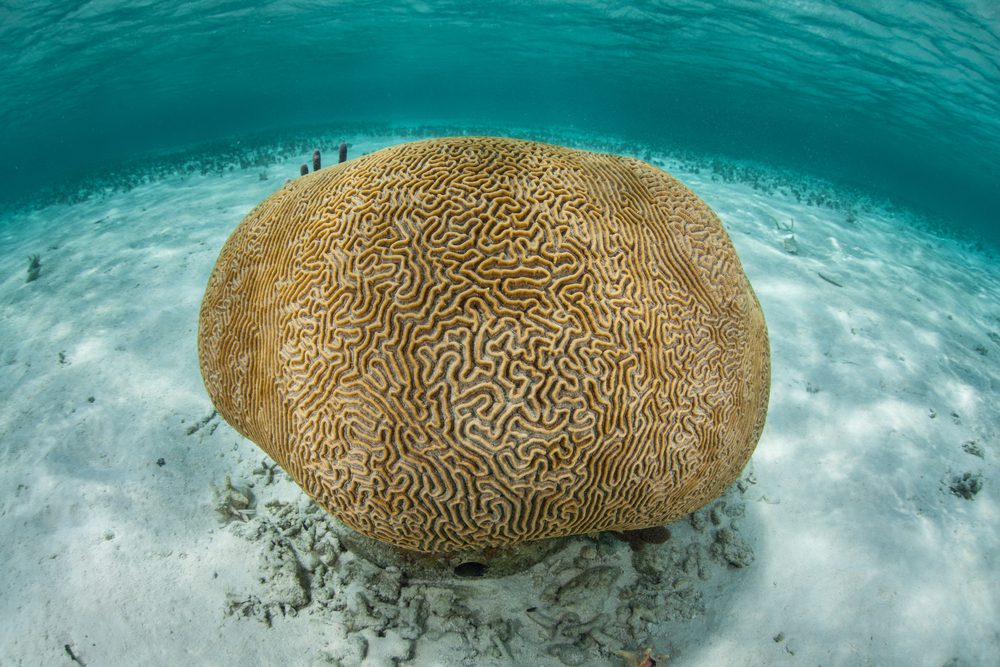
Range: Tropical waters
Diet: Photosynthesis and zooplankton
Size: Depends on species
Life Span: 900 years
Each head of coral is formed by genetically identical polyps that secrete a hard skeleton making them important in the coral reef builders.
Their tentacles are used during the day for protection by wrapping them over the grooves of the surface and at night they are extended to catch food. The Favia Brain coral will extend its tentacles at night and be able to sting the other corals close by.
We have the:
Favia Brain
Welso Brain
Libophibia Brain
Acan Brain
Mushroom Coral
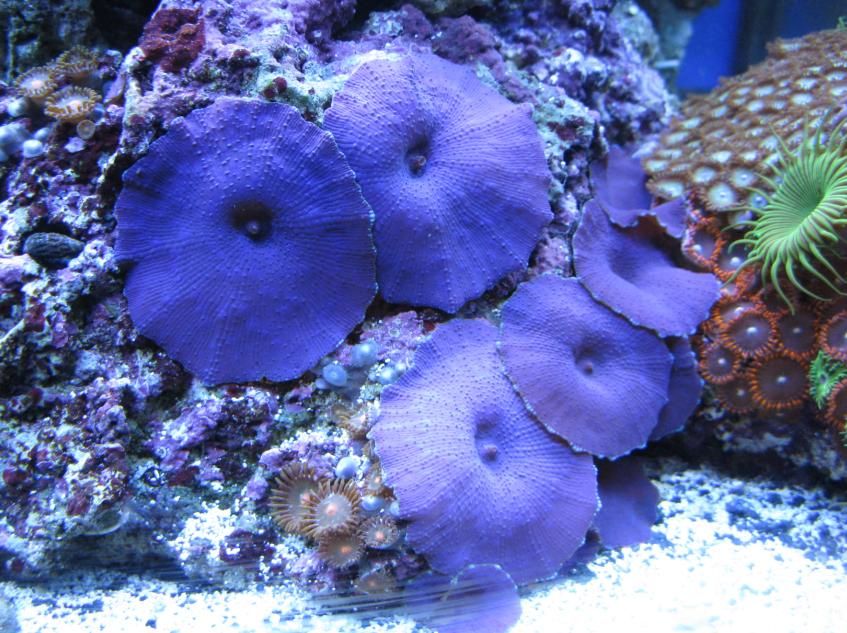
Range: Caribbean
Diet: Crustaceans, small fish, brine shrimp
Size: 1-2 inches
Life Span: 2-13 years
They are of the phylum Cnidaria which is the same phylum that the jellyfish are in. There are many species in this family that range to solitary corals to colonial species. The ones that are in this tank are colonial. Each one of those individual “mushrooms” is one individual that are living together in a colony. They can remain detached from the sand or rock so that they could move around if they wanted to.
They are very hardy corals which is perfect for the beginning aquarists. They can tolerate high levels of nitrates and other organic compounds that will usually kill other fish and corals. However, they will brighten and be healthier with less levels of nitrates and organic compounds.
These corals can be blue, red, green, brown, purple and sometimes with stripes, spots, or mottled color variations.
They will also reproduce until they cover the substrate on what they grow.
These corals will also host the zooxanthellae in a symbiotic relationship. The zooxanthellae provide it nourishment from the sun by photosynthesizing up to 90% of the coral’s energy for metabolism, growth, and reproduction. In return, the coral gives them nutrients, carbon dioxide, and an elevated position towards the sun.
We have Purple and Orange Mushroom Corals
Zoanthids
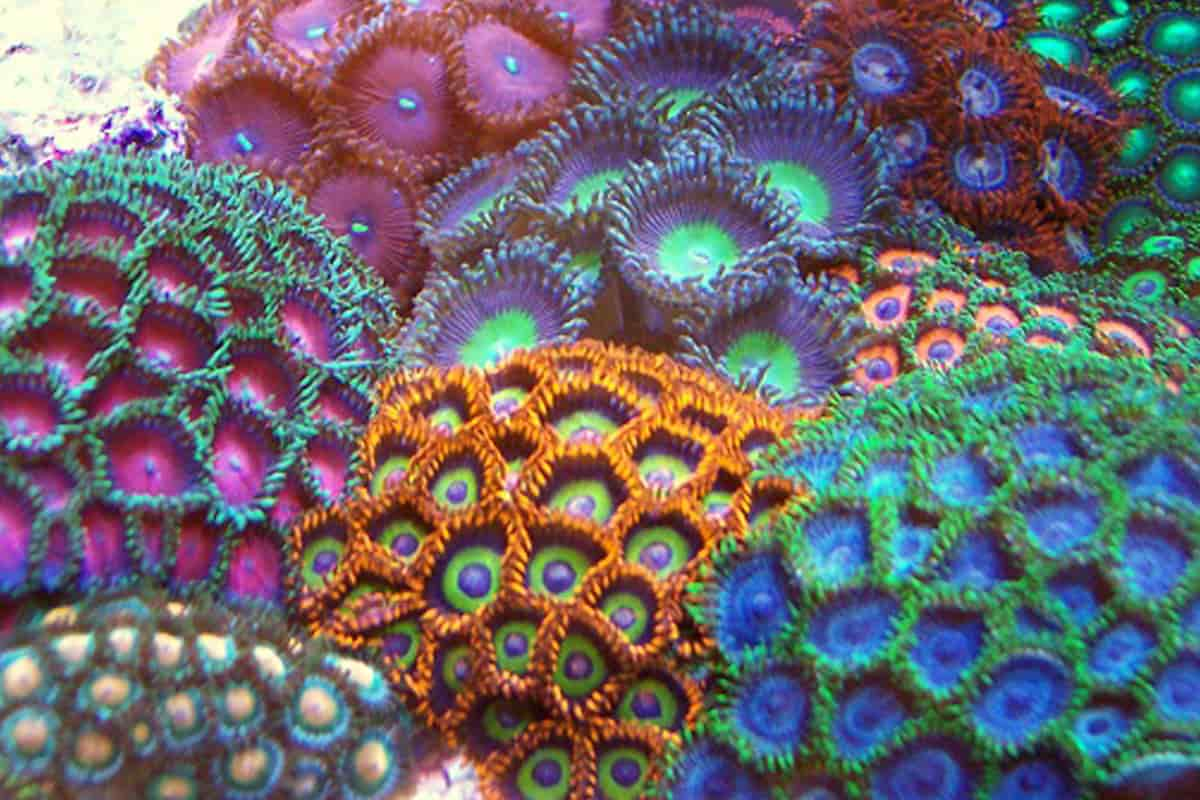
Range: Great Barrier Reef, Caribbean, South Pacific
Diet: Plankton, algae, small meaty foods
Size: 1-2 inches
Scientific Name: Zoantharia
Life Span: Up to 250 years
Zoanthids are in the order of cnidarians which is the same order as jellyfish. They come out in different colonizing formations and colors. They are found as polyps that are attached to sediment, sand and rock.
These guys are unique in that they can incorporate sand and small material into their tissue to help create their structure. Their tentacles are all marginal and filter feed for the plankton and algae floating in the water.
They have a symbiotic relationship with the zooxanthellae. The zooxanthellae provide it nourishment from the sun by photosynthesizing up to 90% of the coral’s energy for metabolism, growth, and reproduction. In return, the coral gives them nutrients, carbon dioxide, and an elevated position towards the sun.
Some zoanthids contain highly toxic substances called palytoxin. Even in small doses, the toxin could be fatal if it is ingested or enters the bloodstream.
Acropora
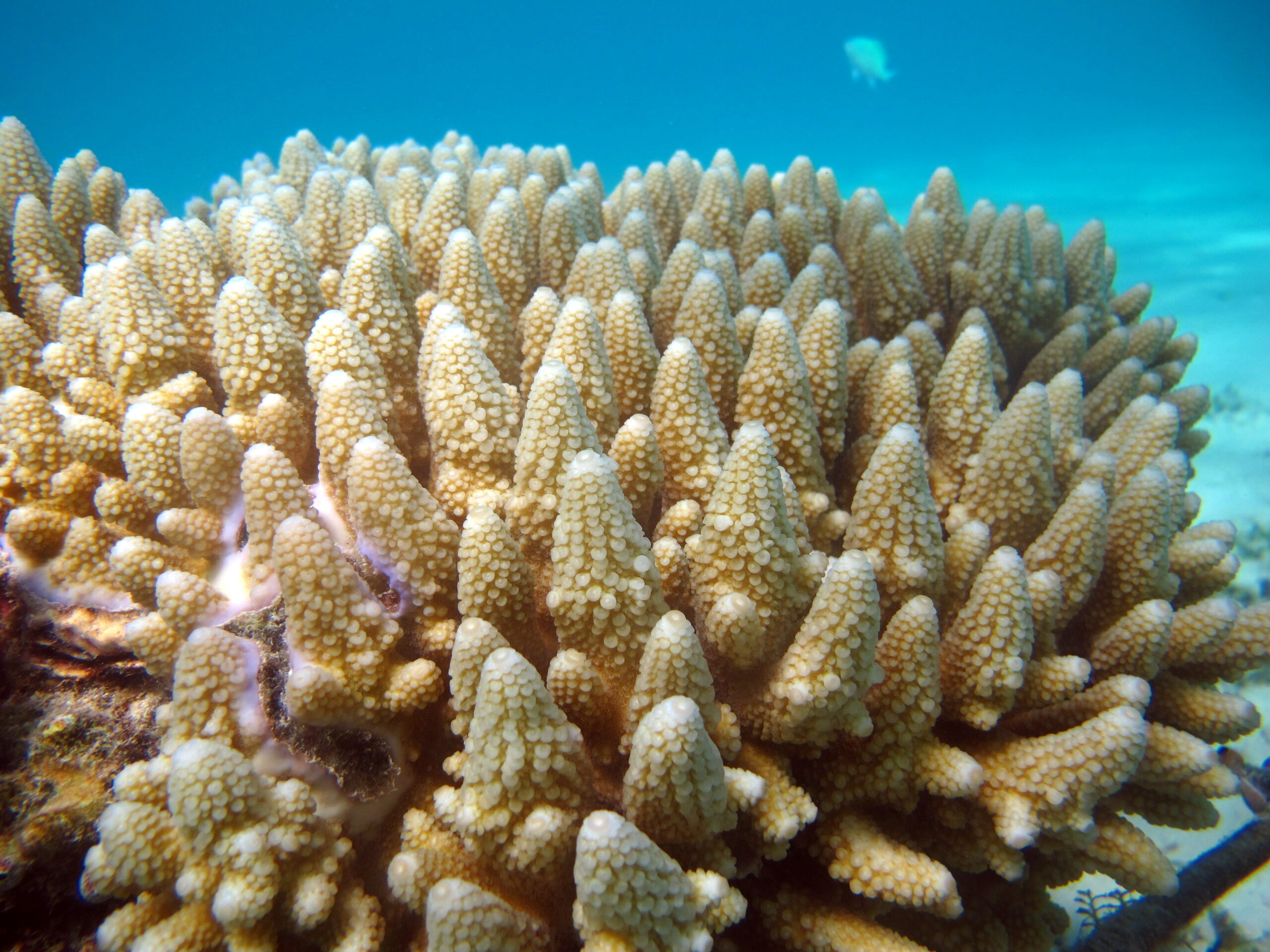
Range: all over the world
Diet: photosynthesis and zooplankton
Size: polyps are 2mm across
Life Span: unknown
The Acropora is a SPS which stands for Small Polyp Stony Coral. Their species are some of the major reef corals that build the immense calcium carbonate substructure that supports the living skin of the reef.
They may grow as plates or slender or broad branches. The individual polyps share tissue and a nerve net. They are able to withdraw into the coral in response to either disturbance or movement. At night the polyps will extend further to help capture food.
Frogspawn
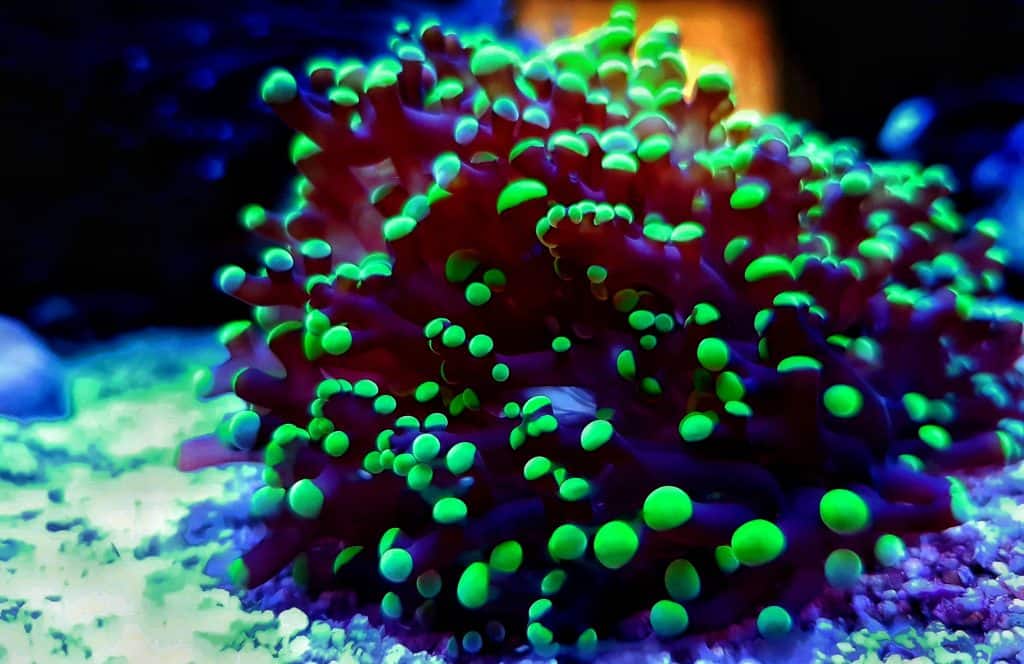
Range: Indo-Pacific Islands
Diet: photosynthesis and zooplankton
Life Span: unknown
Frogspawn is a LPS meaning Large Polyp Stone Coral. Depending on the frogspawn, the growth rate will vary. Thicker skeletons will take longer whereas less thick can grow to over 30 new heads a year.
Gorgornian – Sea Whip
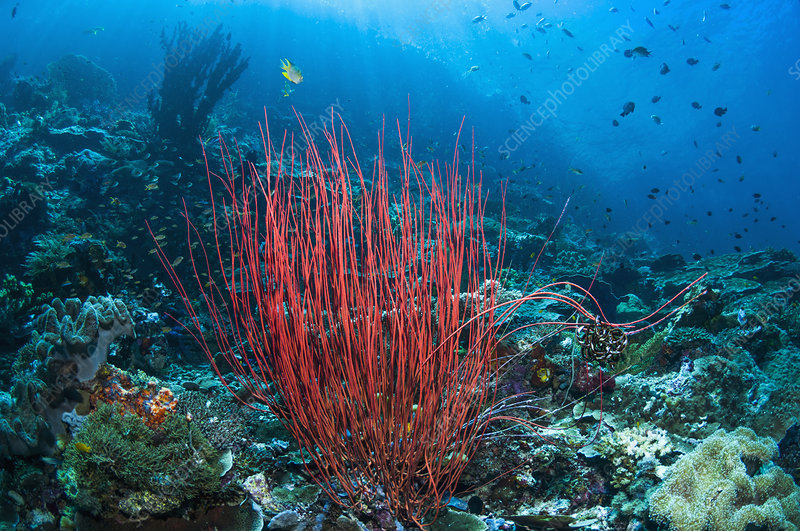
Range: Abundant in Western Atlantic
Diet: photosynthesis and zooplankton
Size: Several feet high and across
Life Span: 4 to 12 years for individual polyps
Gorgornian corals are soft corals known as sea fans and sea whips. They are brightly colored often, purple, red, or yellow. Gorgornians have minute spiny skeletal elements that five them some support and gives them a spiky grainy texture to deter predators.
Each Gorgonian polyp has eight tentacles to filter feed. They also have the symbiotic relationship with zooxanthellae that photosynthesizes and gives the coral the nutrients, energy, and color that it receives.
Montipora
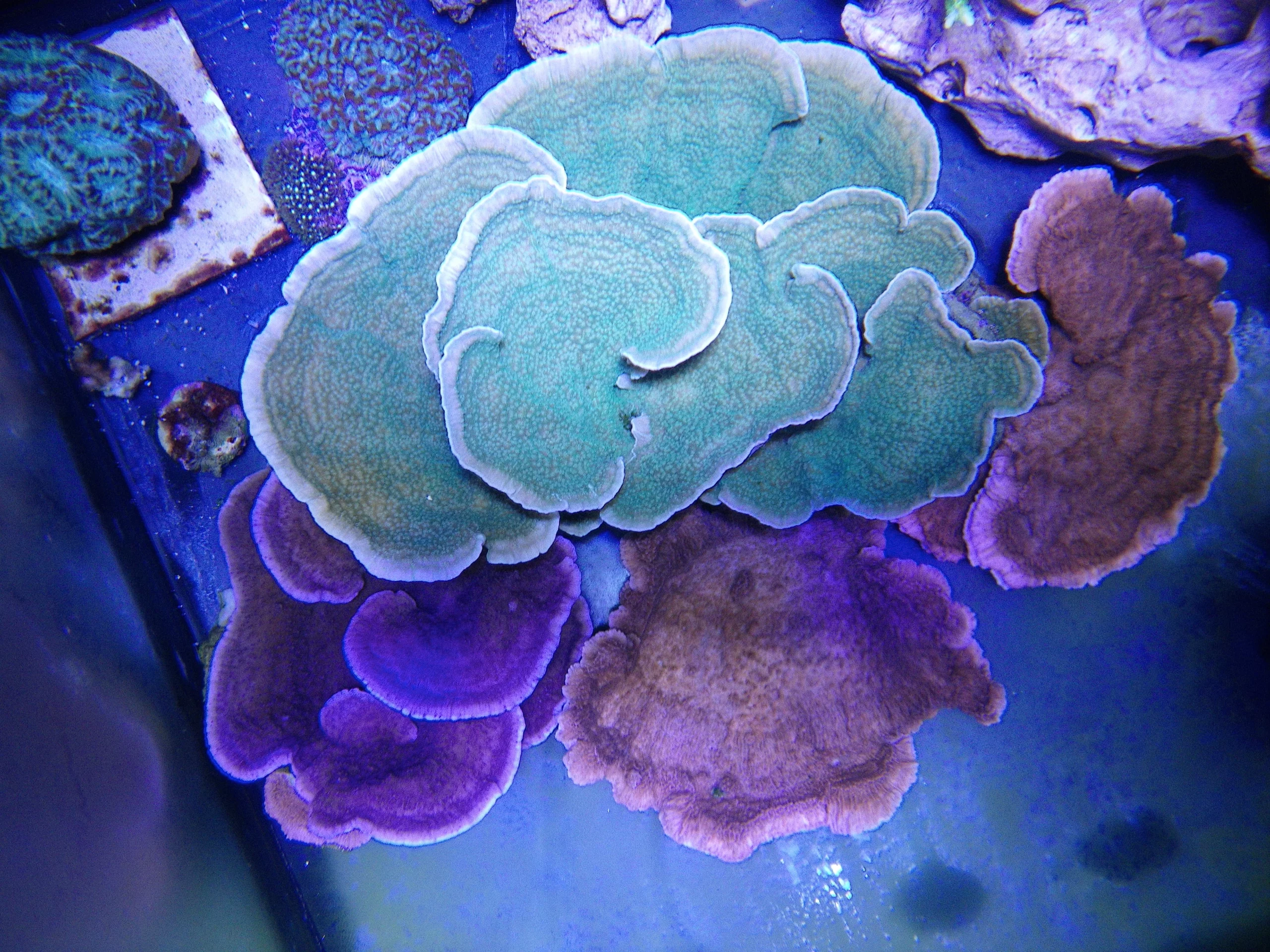
Range: Indo-Pacific Region and Red Sea
Diet: photosynthesis and zooplankton
Life Span: unknown
Montiporas have over 85 known species being the second most species rich coral after the acropora.
They have many growth morphologies that may be different even in one colony. This coral forms colonies that expand by adding to their foundations and spreading out further. The individual polyps are transparent and reside within the small bumps on the surface to emerge at night.
We have the:
Blue Encrusting Montipora
Red Montipora
Green Montipora
Orange Encrusting Montipora
Neon Spongotus Montipora
Capricornus Montipora
Spongoid Montipora
Leptoseris
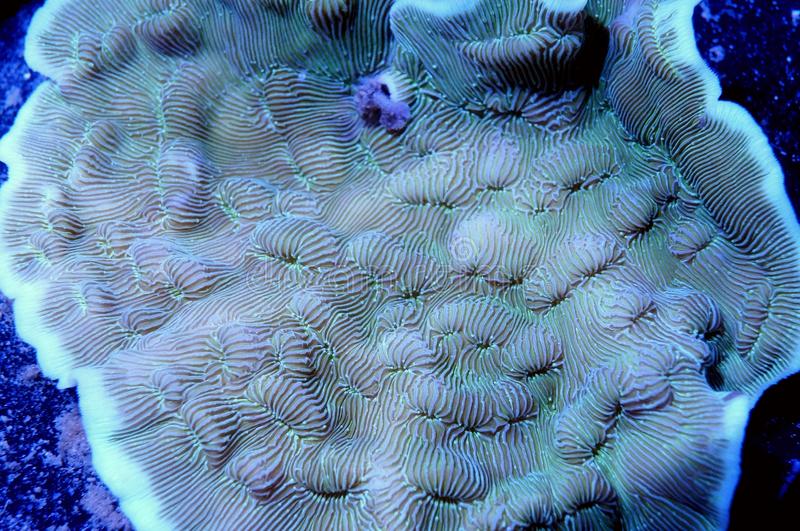
Range: Solomon Islands
Diet: photosynthesis and zooplankton
Life Span: unknown
Leptoseris is a wrinkle coral that can be found growing vertical or overhung reef walls. They can grow either as encrusting or tiered fashion with the color range of brown to green. It has short tentacles that can harm other invertebrates.
It is a SPS which is a Small Polyp Stony coral.
Birds Nest
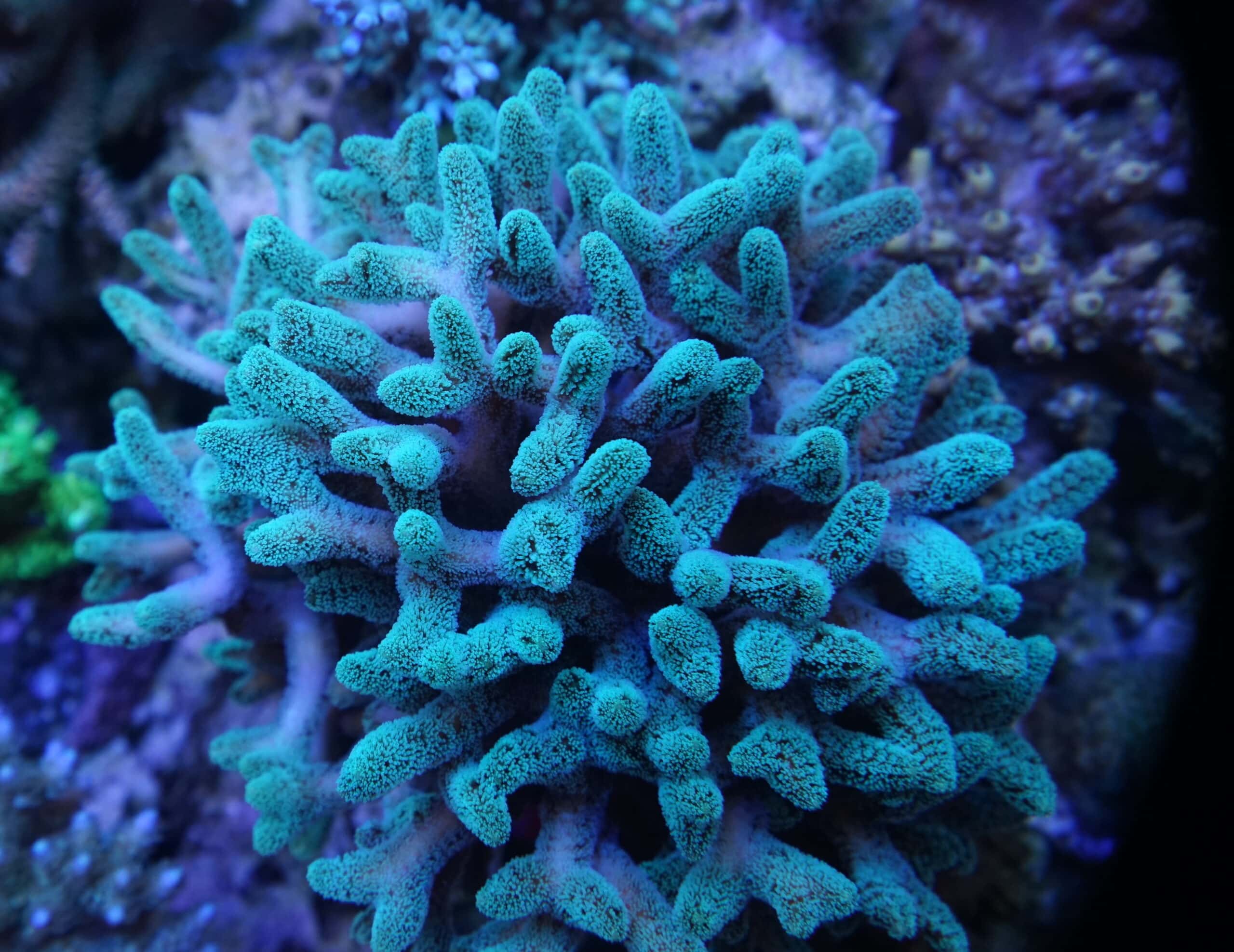
Range: Tonga, Jakarta, Bali
Diet: photosynthesis and zooplankton
Life Span: unknown
Birds Nest is a SPS coral, Small Polyp Stony coral. They are fairly aggressive corals in that they can sting nearby competitors and may even release a toxin to further deter them.
Chalice Stone
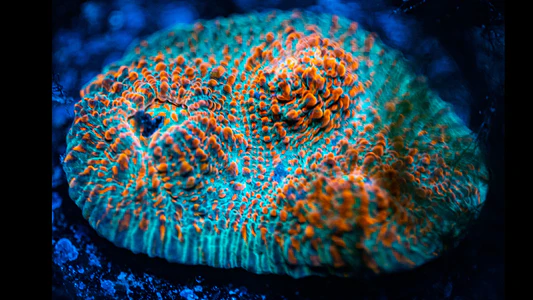
Range: Indo-Pacific Region
Diet: photosynthesis and zooplankton
Life Span: unknown
The Chalices has an encrusting growth where colonies can form folds or cups. The colors of their mouths are usually different than the rest of their body. It’s tentacles are classified as sweeper tentacles which means that it can invade and sting nearby corals
Galaxea
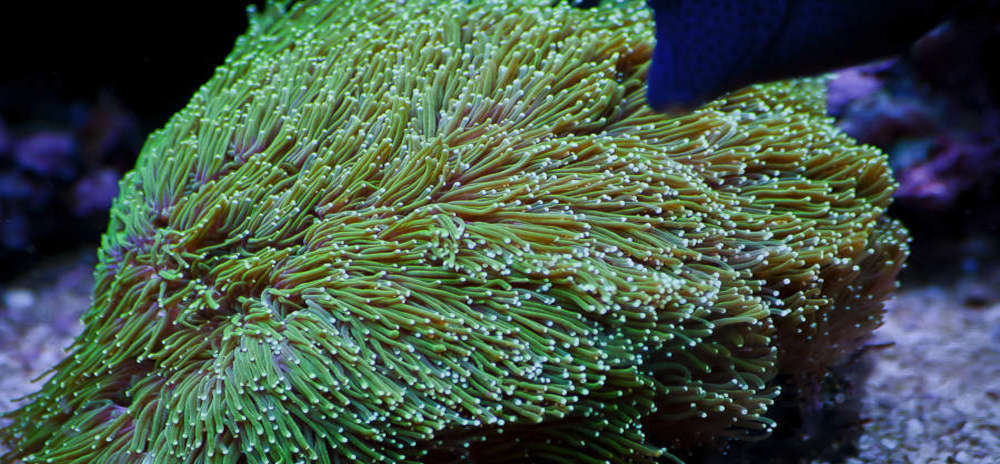
Range: Indo-Pacific Region
Diet: photosynthesis and zooplankton
Size: up to 16 feet
Life Span: unknown
Galaxea polyps feed during the daytime. When their tentacles are extended the basic skeleton of the coral is hidden. The tentacles have a contrasting colors with the tip being white and some are modified into sweeper tentacles that has the ability to sting other invertebrates up to 12 inches away.
Hammer coral
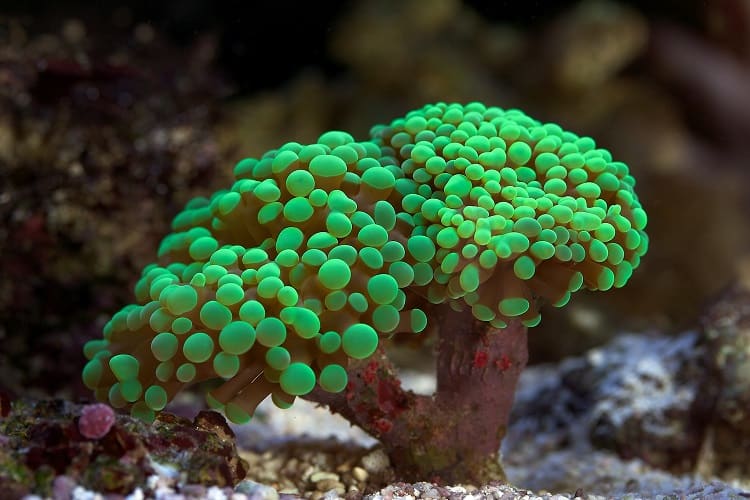
Range: Pacific Reefs
Diet: Photosynthesis, mysis and brine shrimp
Size: some colonies can reach over 3 feet
Life Span: unknown
The Green Hammer Coral is considered a LPS coral which stands for Large Polyp Stony Coral.
They have potent sweeper tentacles that can reach up to 6 inches and will sting anything within reach of its nematocysts including other coral colonies. Its tentacles resemble hammers which is why it’s called a hammer coral.
Trumpet Coral
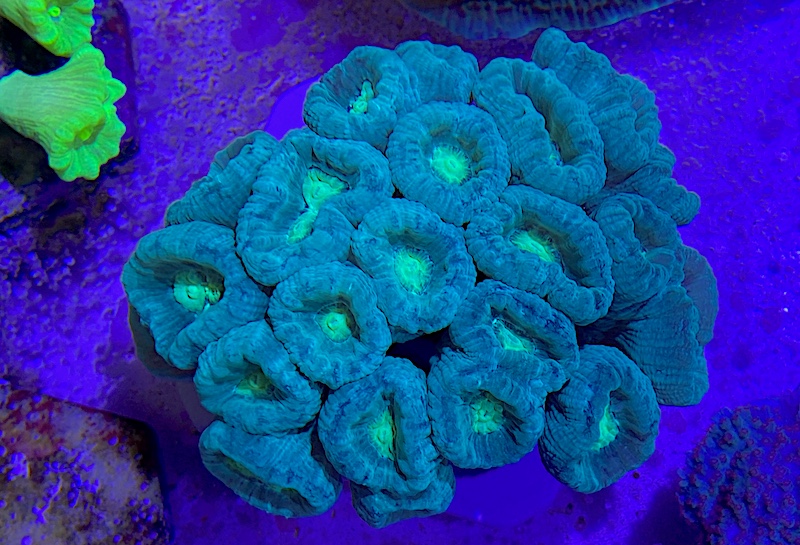
Range: Tonga
Diet: Photosynthesis and zooplankton
Life Span: unknown
Trumpet corals has heads that branches from a central point that looks like a trumpet. These polyps covers each head of the colony and is able to expand many times its skeleton size which makes it similar in appearance to a closed brain coral.
It has short sweeper tentacles to sting other invertebrates.
Sunset Chalice
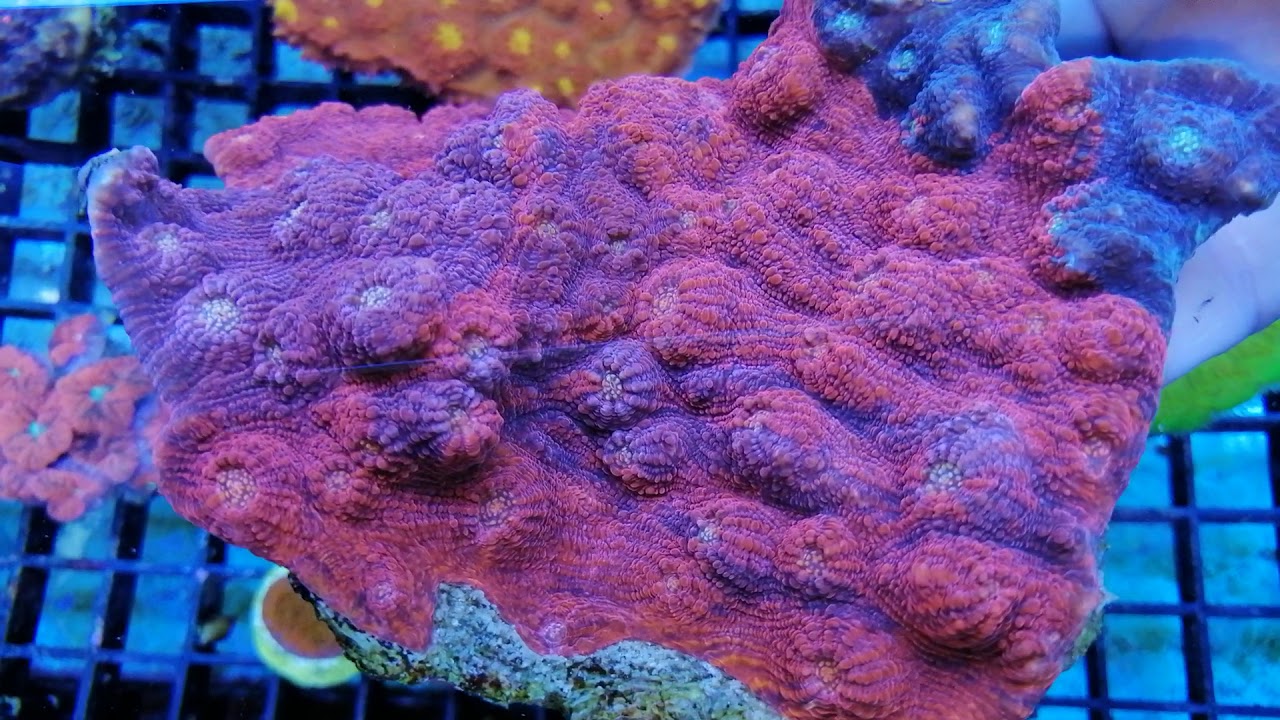
Range: Pacific Ocean
Diet: Photosynthesis and zooplankton
Size: 5 inches
Life Span: unknown
The Sunset Chalice is able to both encrust as well as plate. They can also produce sweeter tentacles to sting other invertebrates around them and feed mostly at night.
Reef Ecosystem
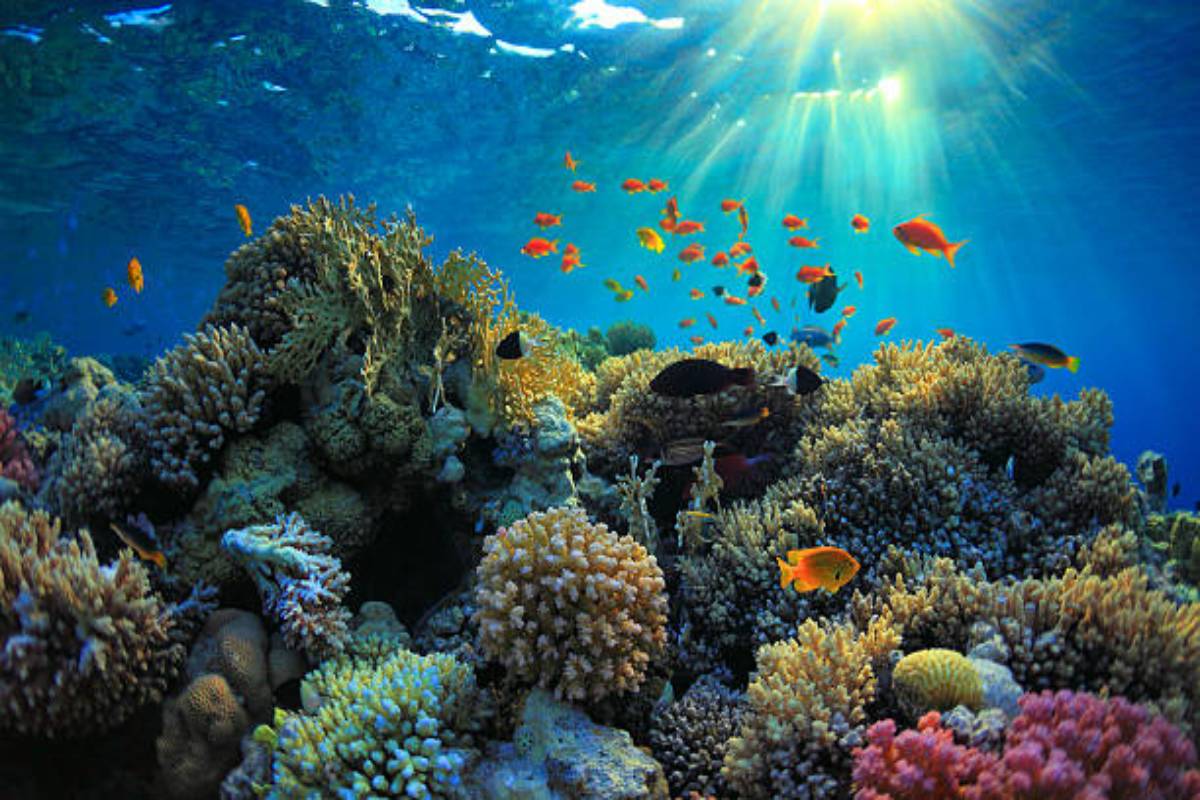
Another name for coral reefs are “rainforests of the sea.” They were formed after the last glacial period when all that melting ice rose the sea levels making reefs less than 10,000 years old.
Most of them require warm, shallow, clear, sunny, and agitated water with few nutrients. They occupy only less that 0.1% of the world’s ocean area yet houses at least 25% of all the marine species. This includes fish, mollusks. Worms, crustaceans, echinoderms, sponges, tunicates, and other cnidarians.
Corals have growth rings just like trees. They are closely related to jellyfish and anemones. There is a close mutualistic symbiotic relationship between corals and algae. The algae receives protection from the coral and the coral receive the energy and nutrients that comes from the algae photosynthesizing.
There are different catagories of corals. The hard coral forms reefs and create a calcium carbonate skeletal structure. This is also divided into two with the Large Polyp Coral and the Small Polyp Coral. The second category is the soft coral that are present in reef ecosystems though they do not form the skeletal structure.
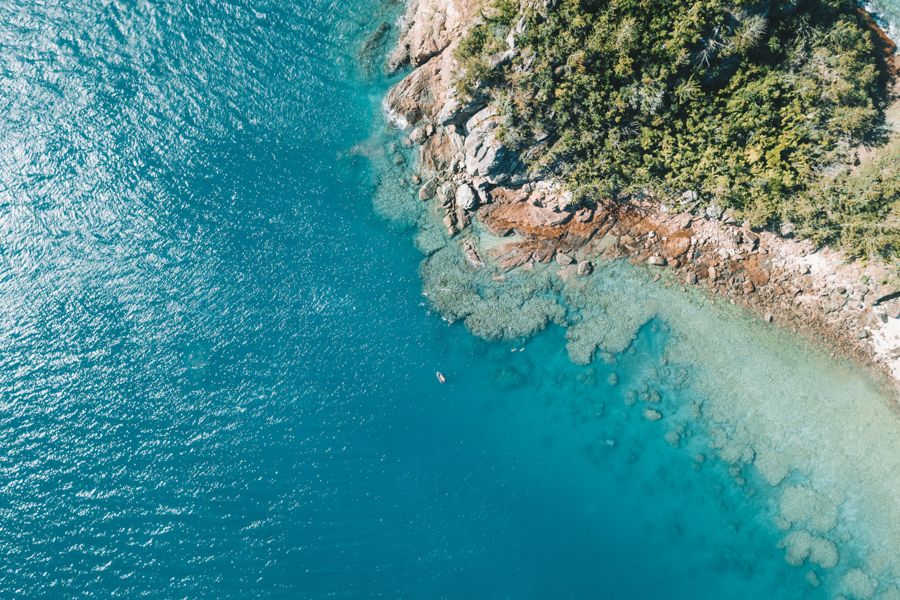
Fringing Coral Reefs
There are three different types of coral reefs. One is called Fringing which is when the reef attaches to the land and grows into the water. This is commonly found in the Caribbean and the Red Sea.

Atoll Coral Reefs
Atoll Corals Reefs originate from underwater volcanos and completes a circle in the open water. Most of these are found in the Pacific Ocean.
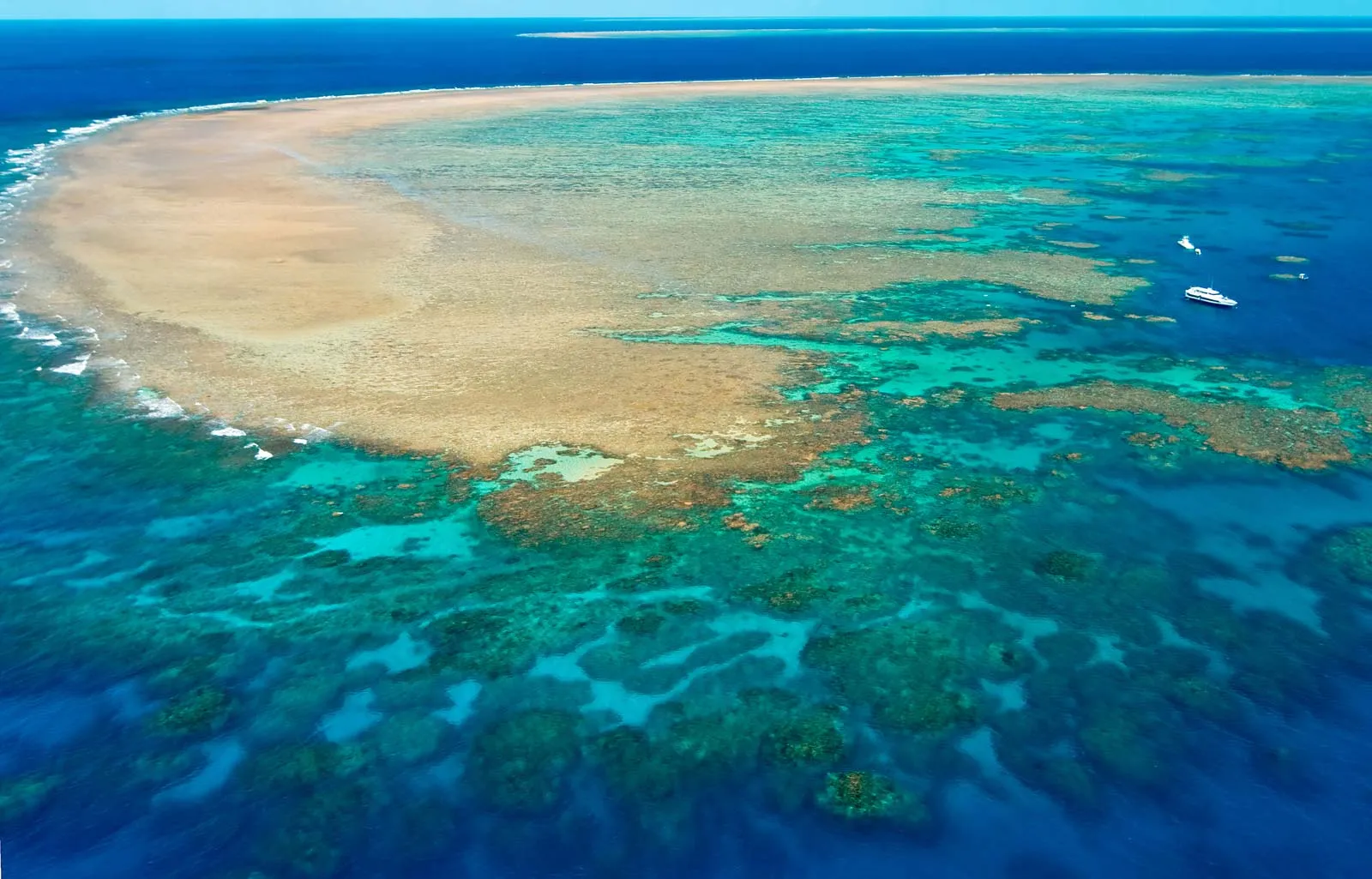
Barrier Coral Reefs
Barrier Reefs are parallel to the shoreling to form a barrier that creates channels out in the ocean and are popular for snorkeling and diving destinations.
The Great Barrier Reef is the largest reef system in the world and you are able to see it from space. There is even looks like a heart and is called the heart reef. It holds over 2900 individual reefs
There was also a bio control to reduce the amount of invasive algae species. This invasive species chokes out the corals and anemones, killing them and putting the reef in danger. The collector urchins are good for eating this type of algae but divers have also gone down and removed them by hand.
Please be aware and protect our oceans!